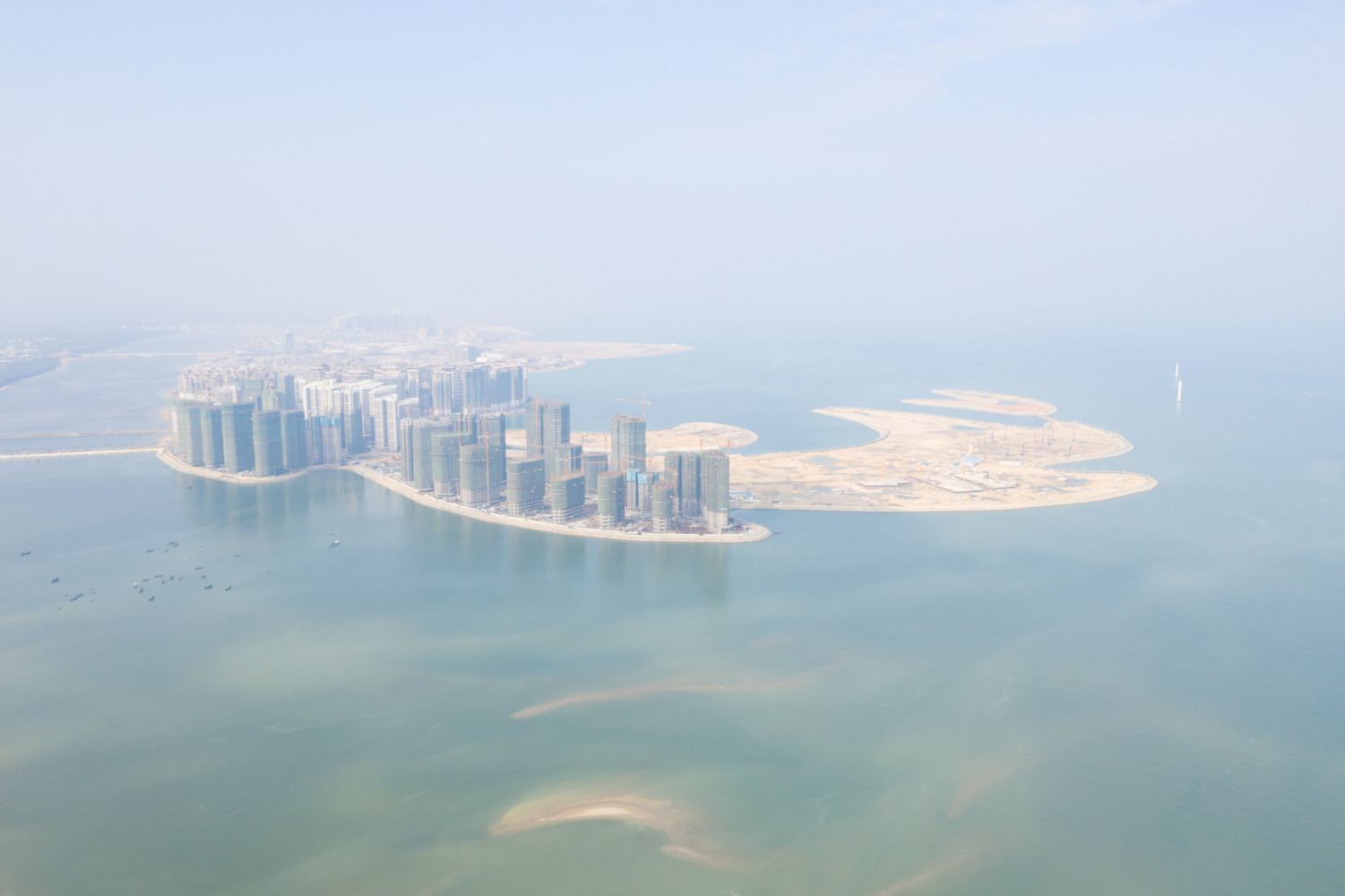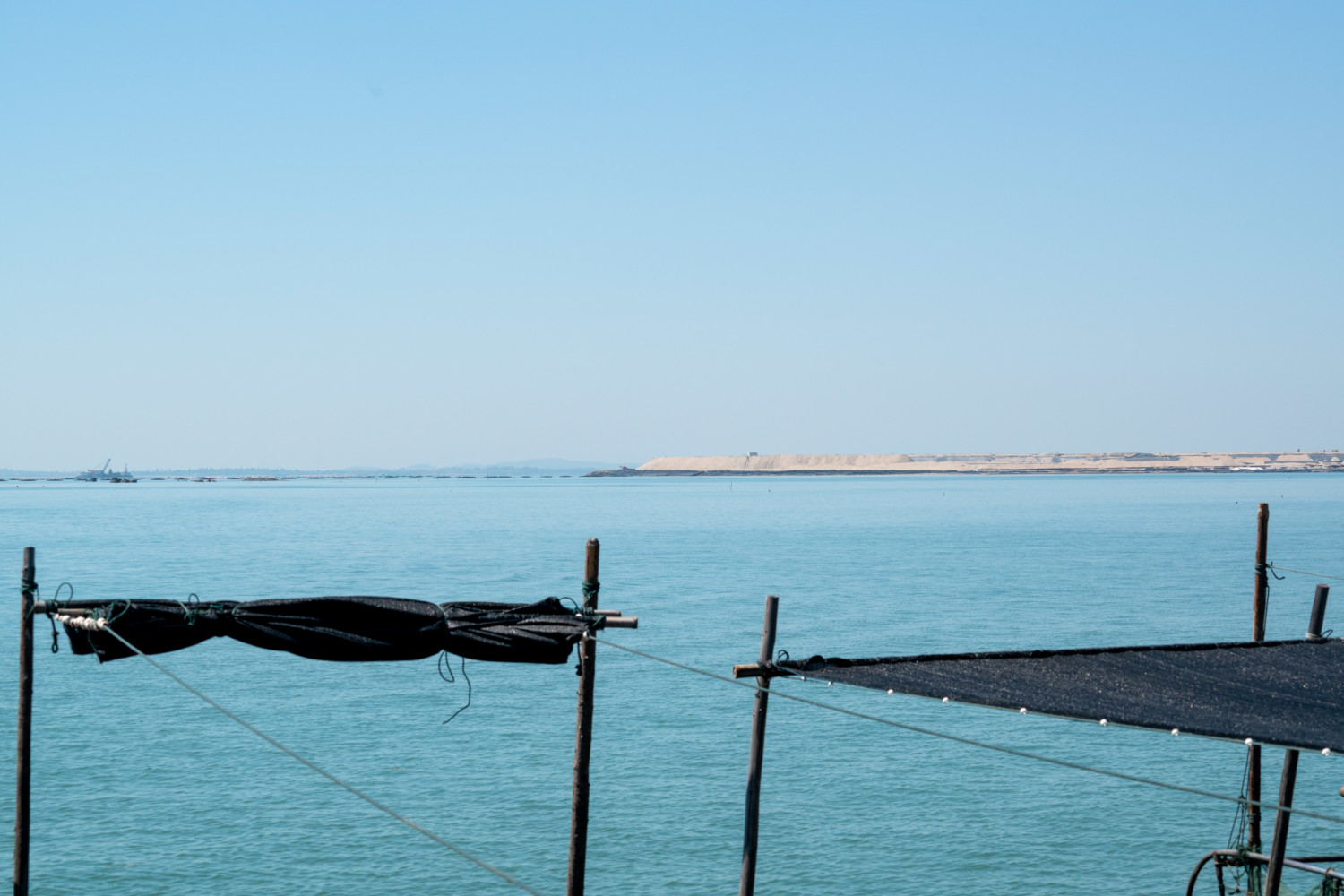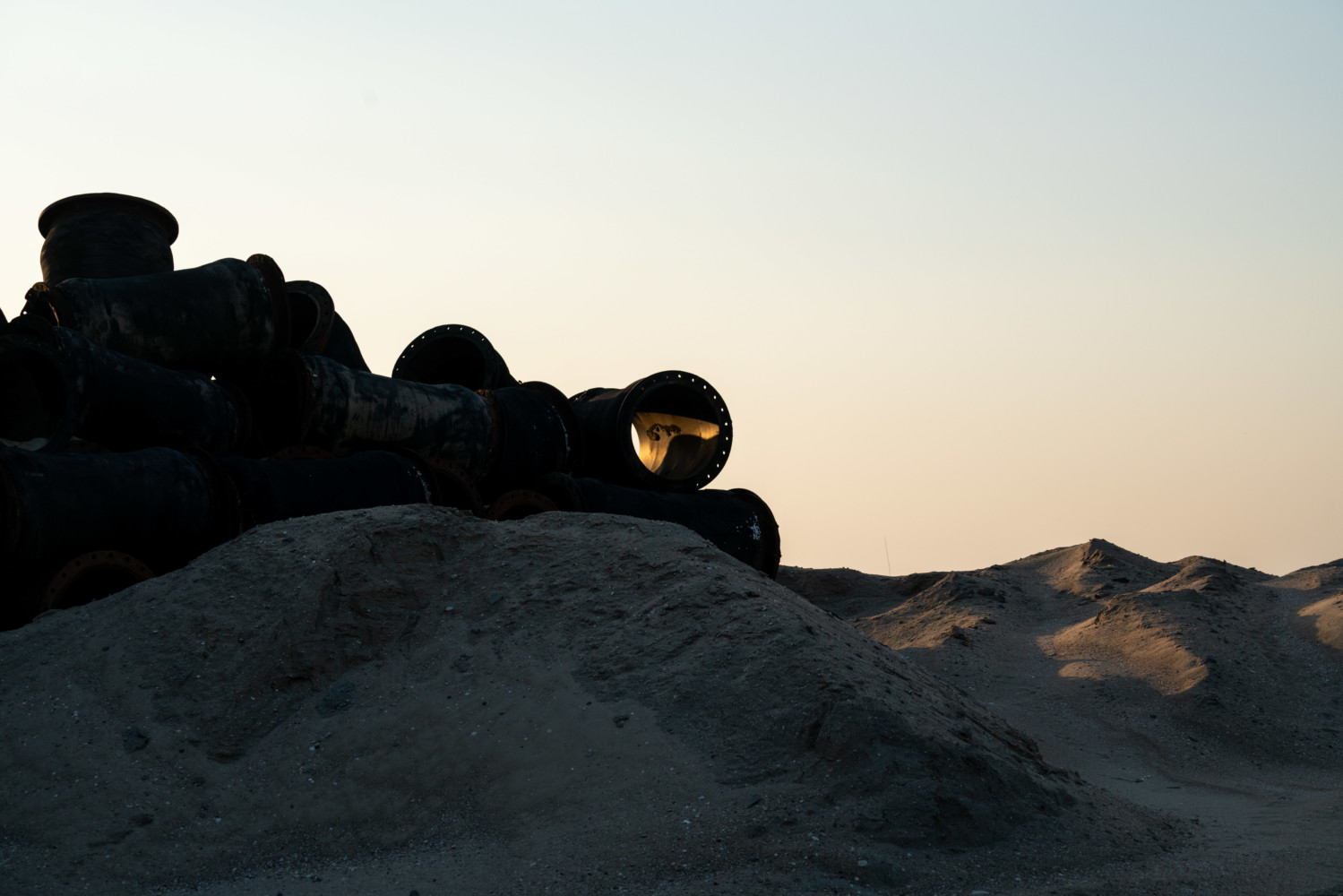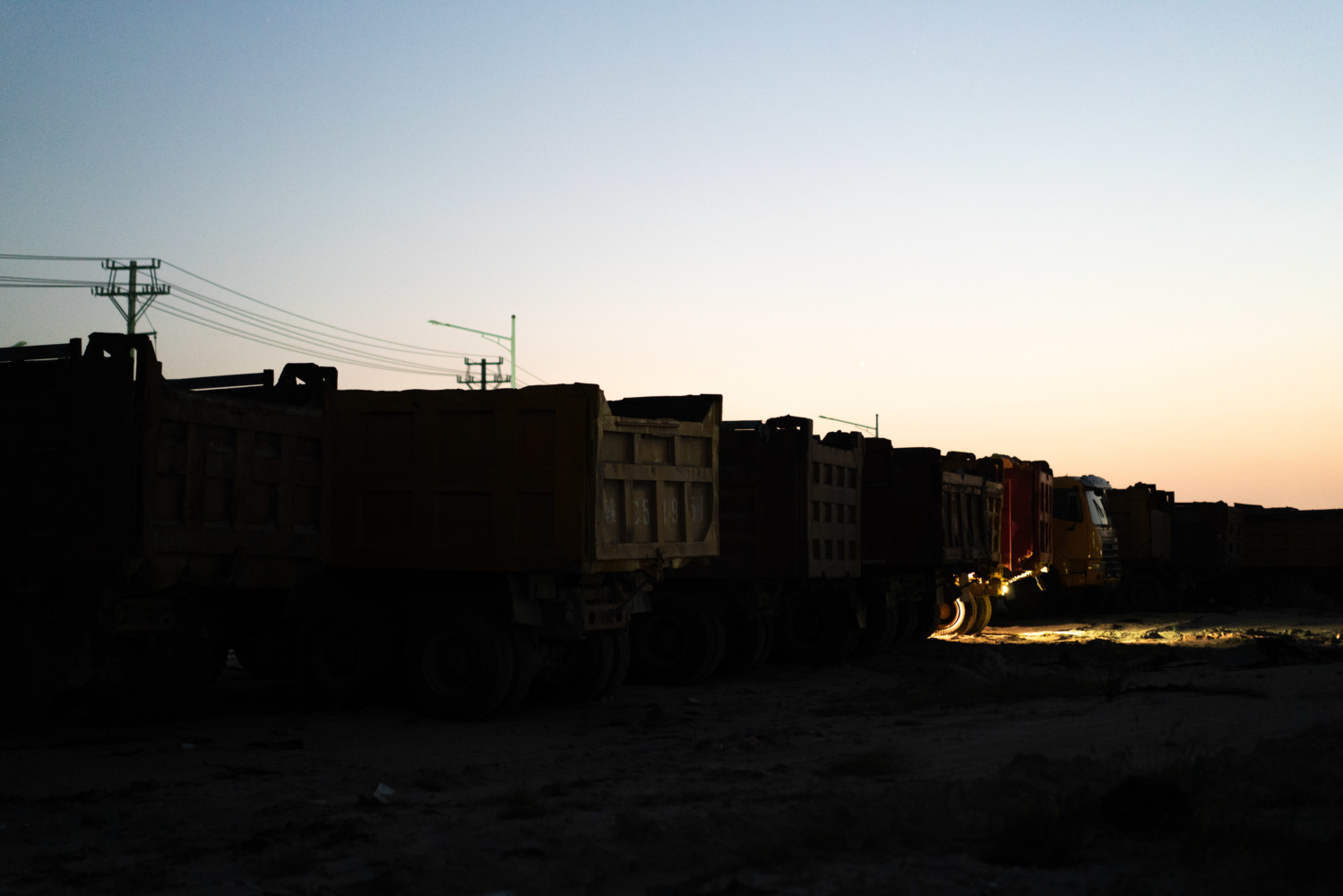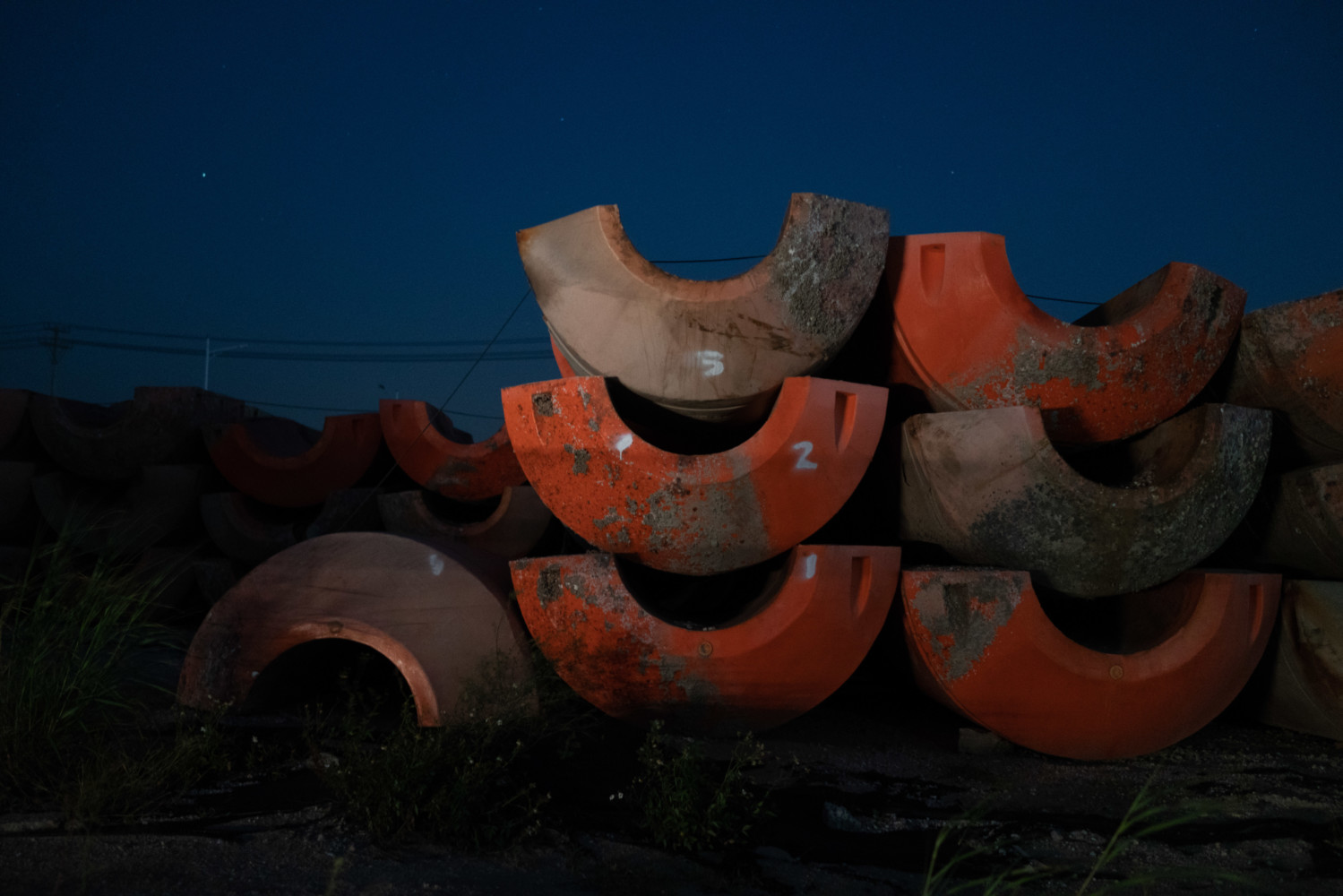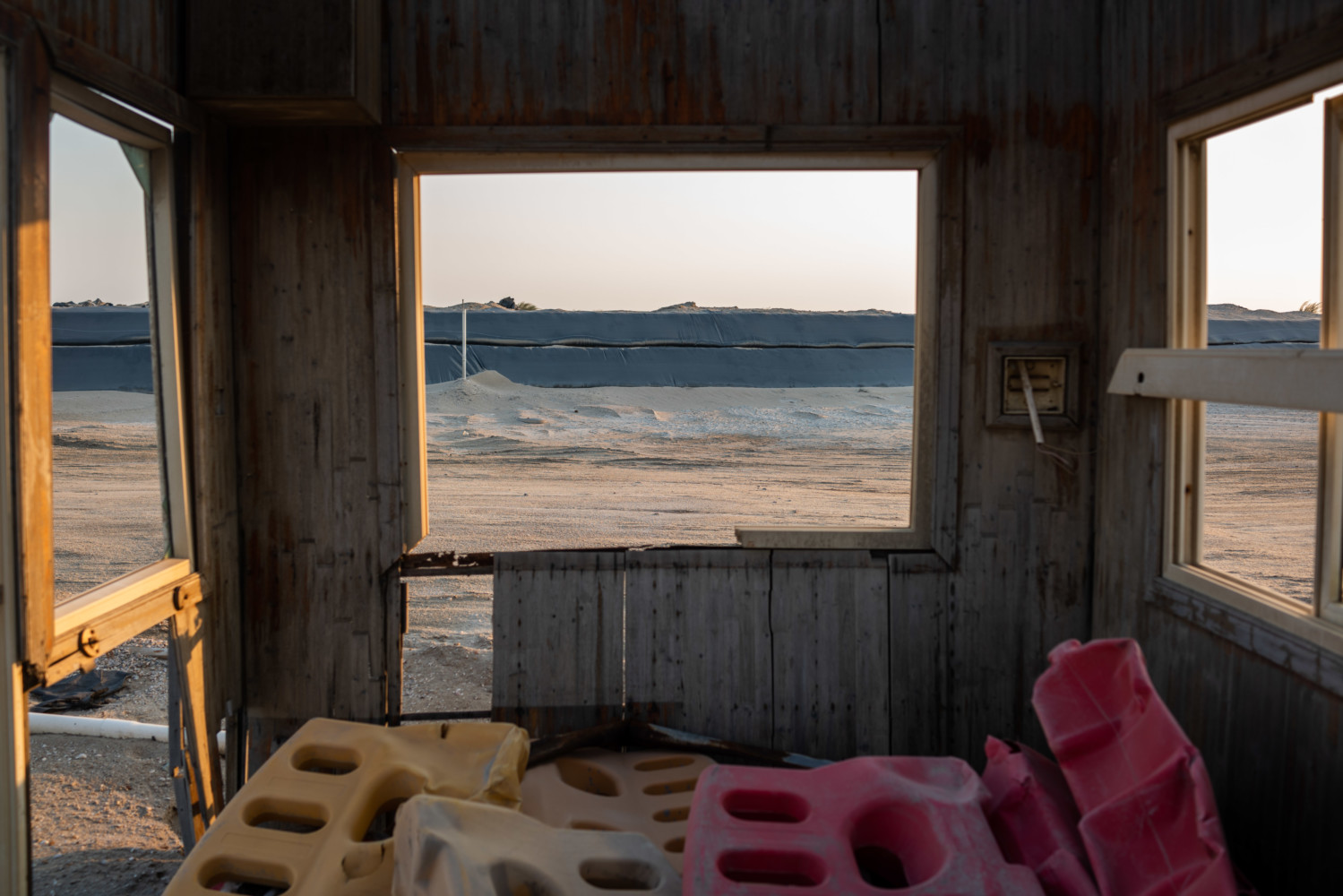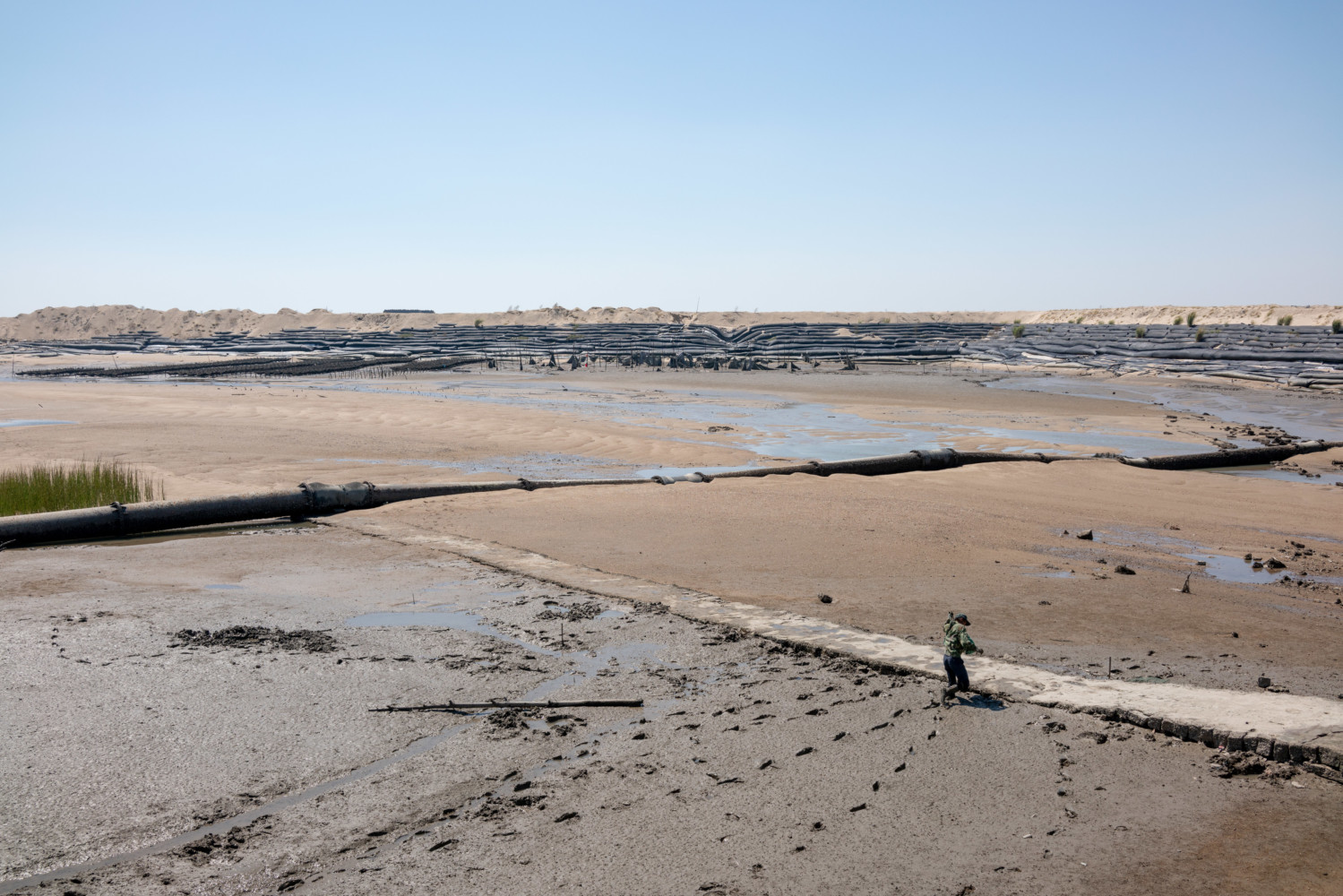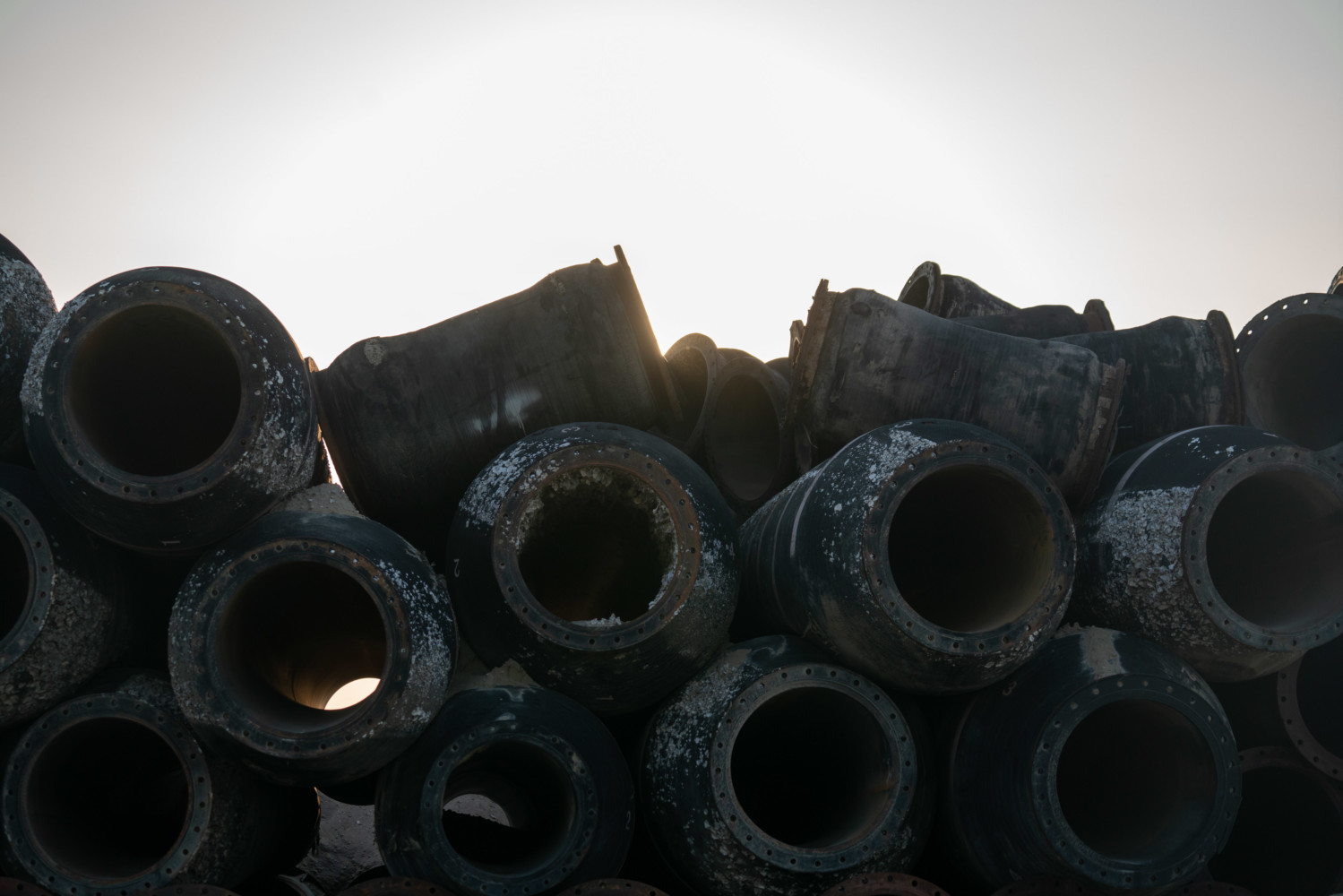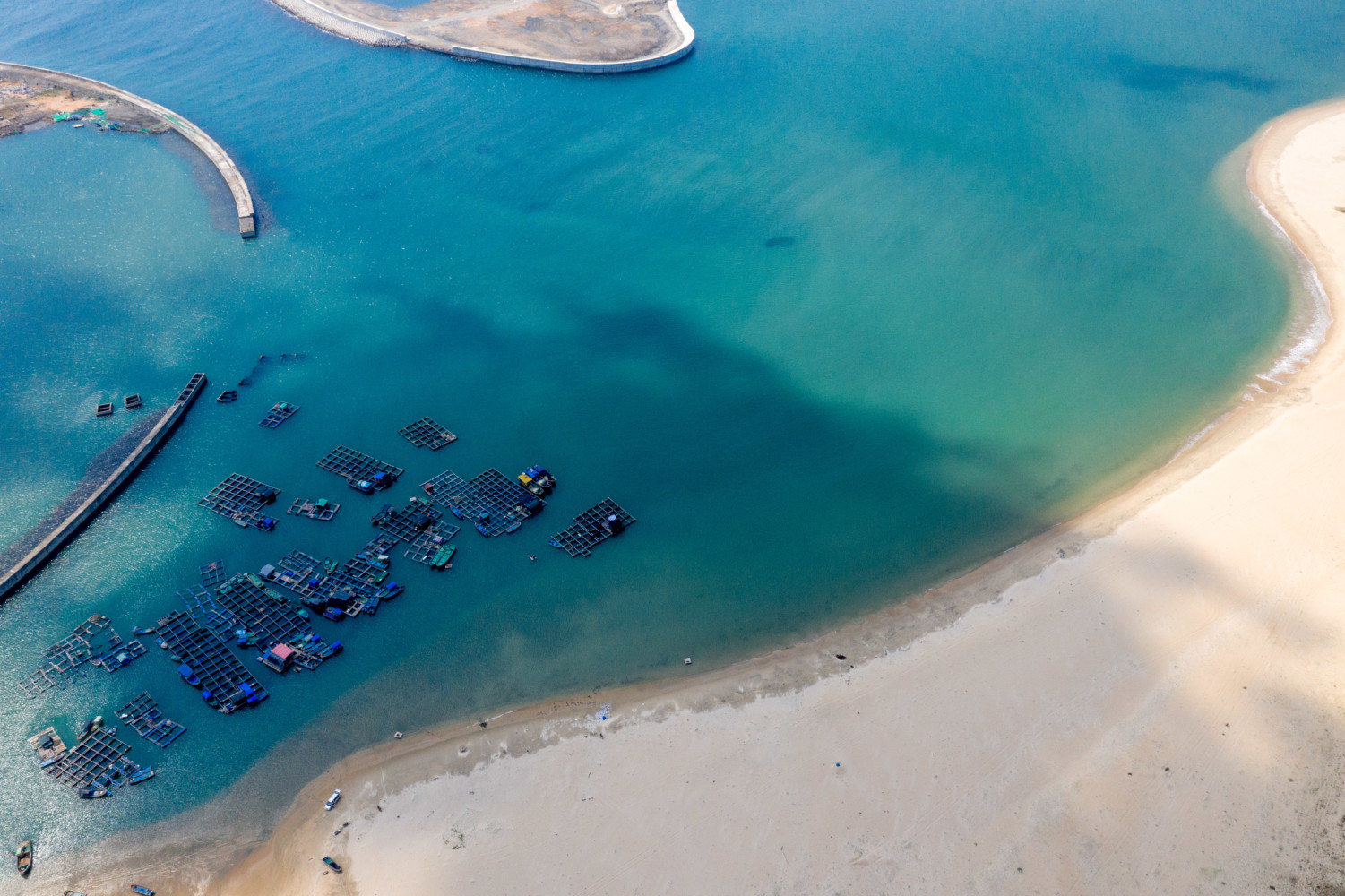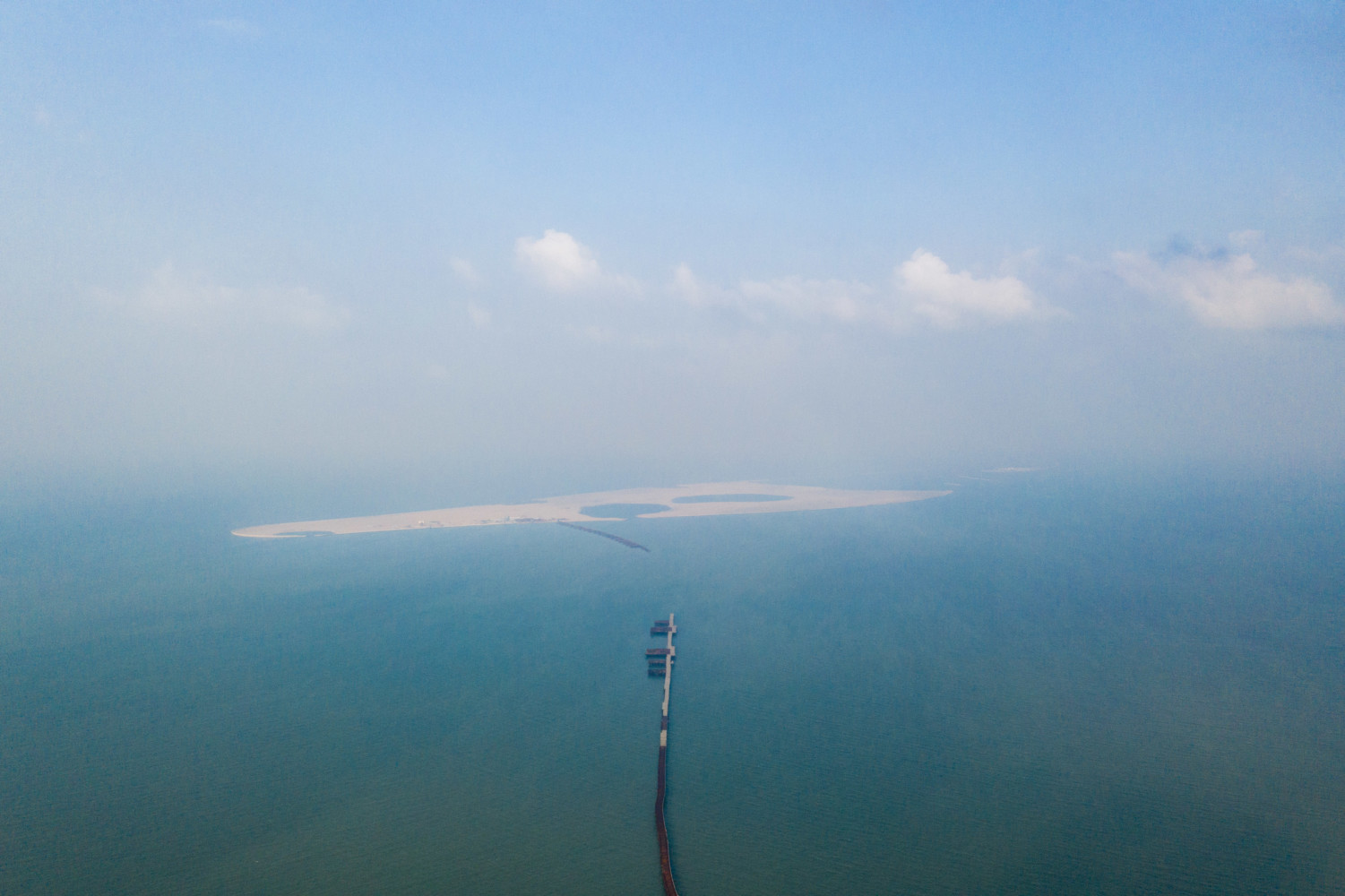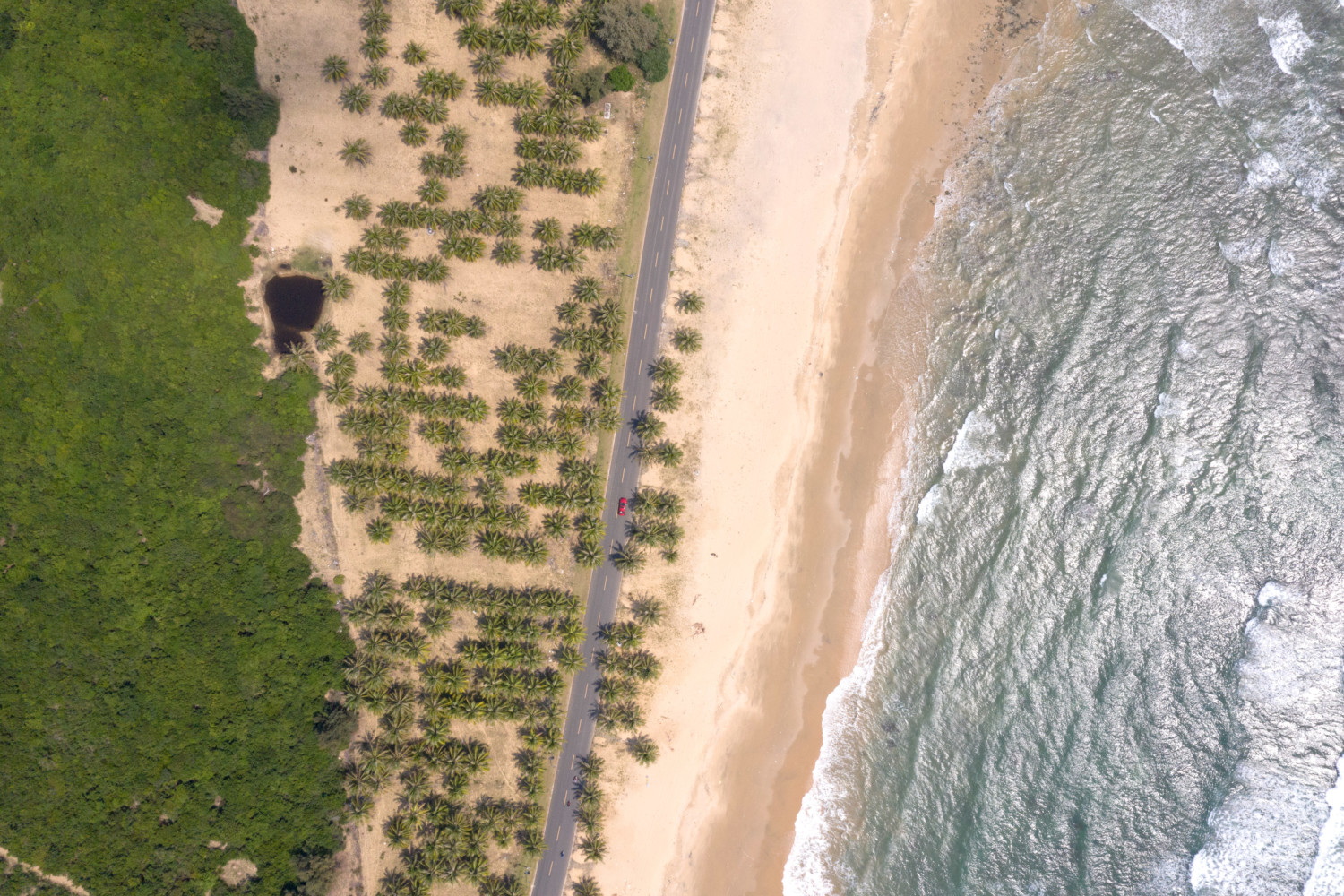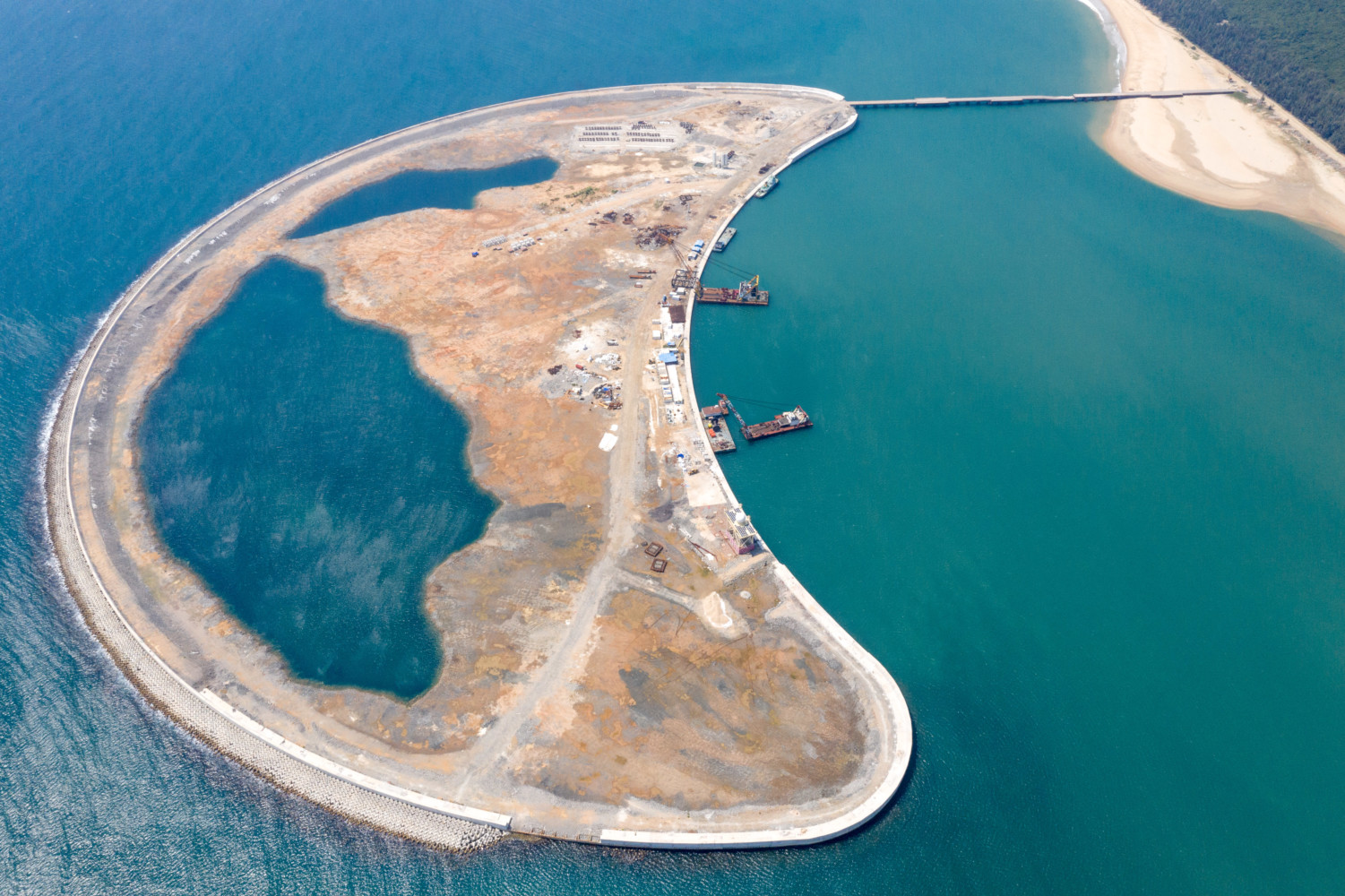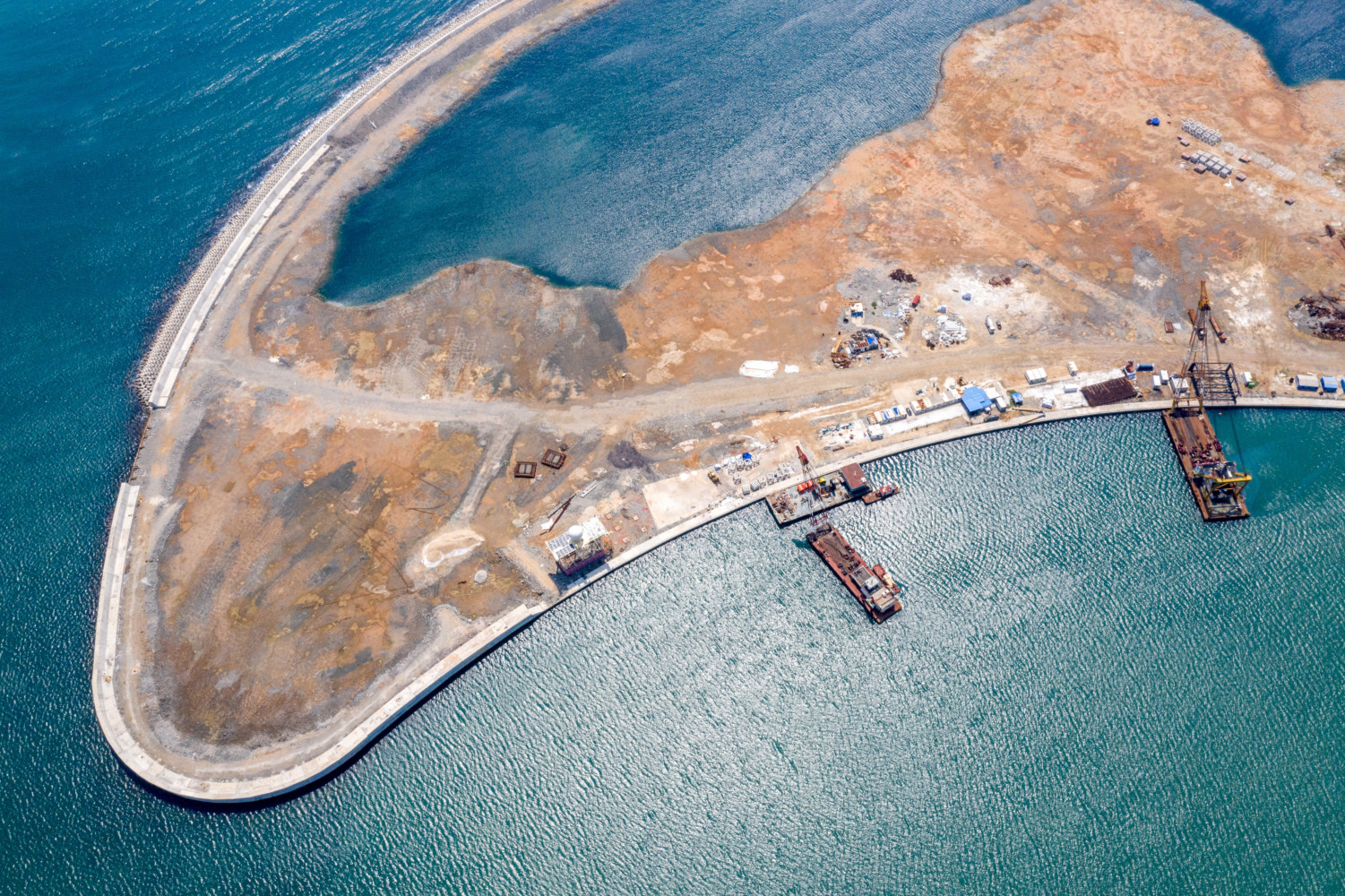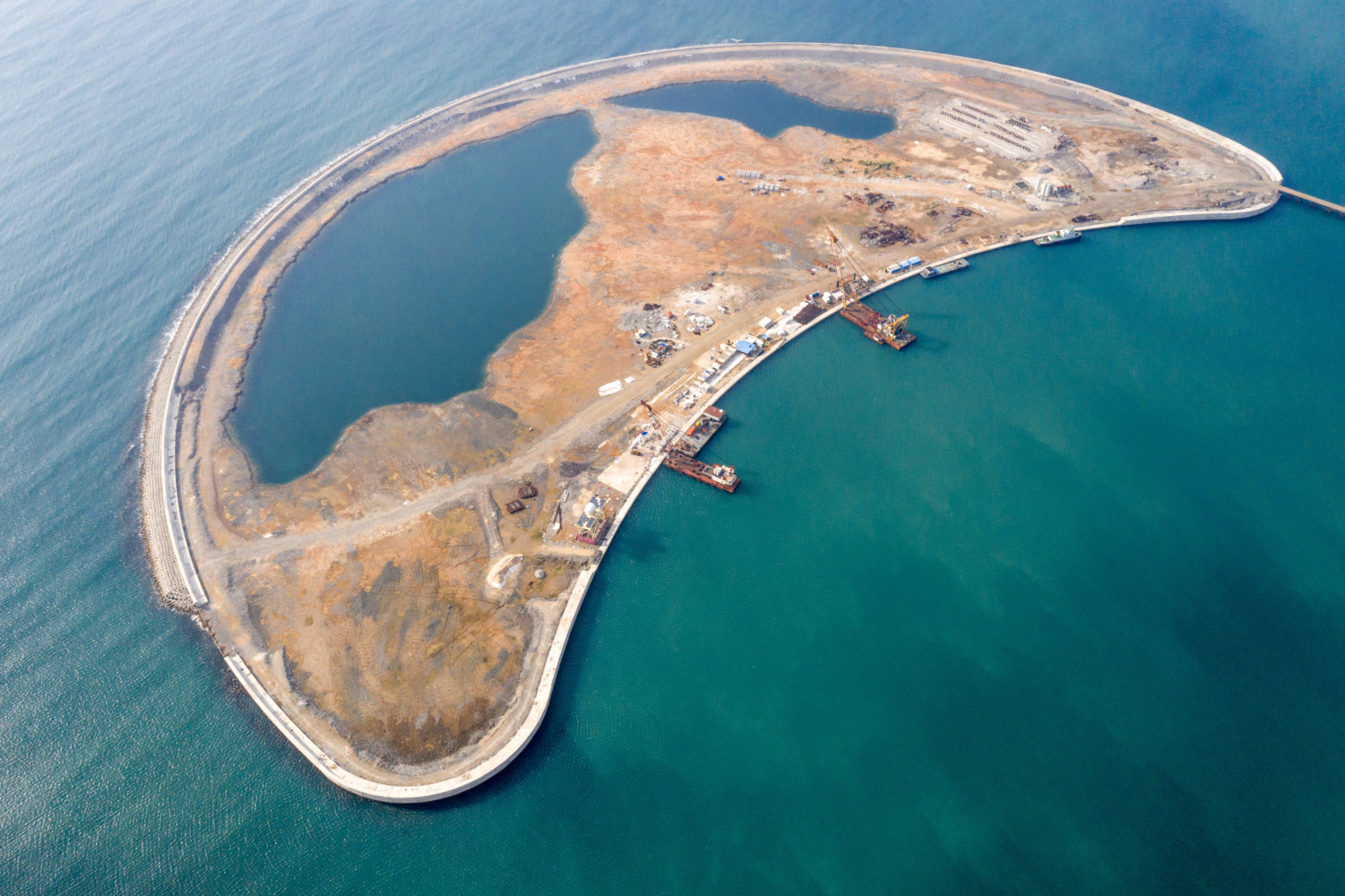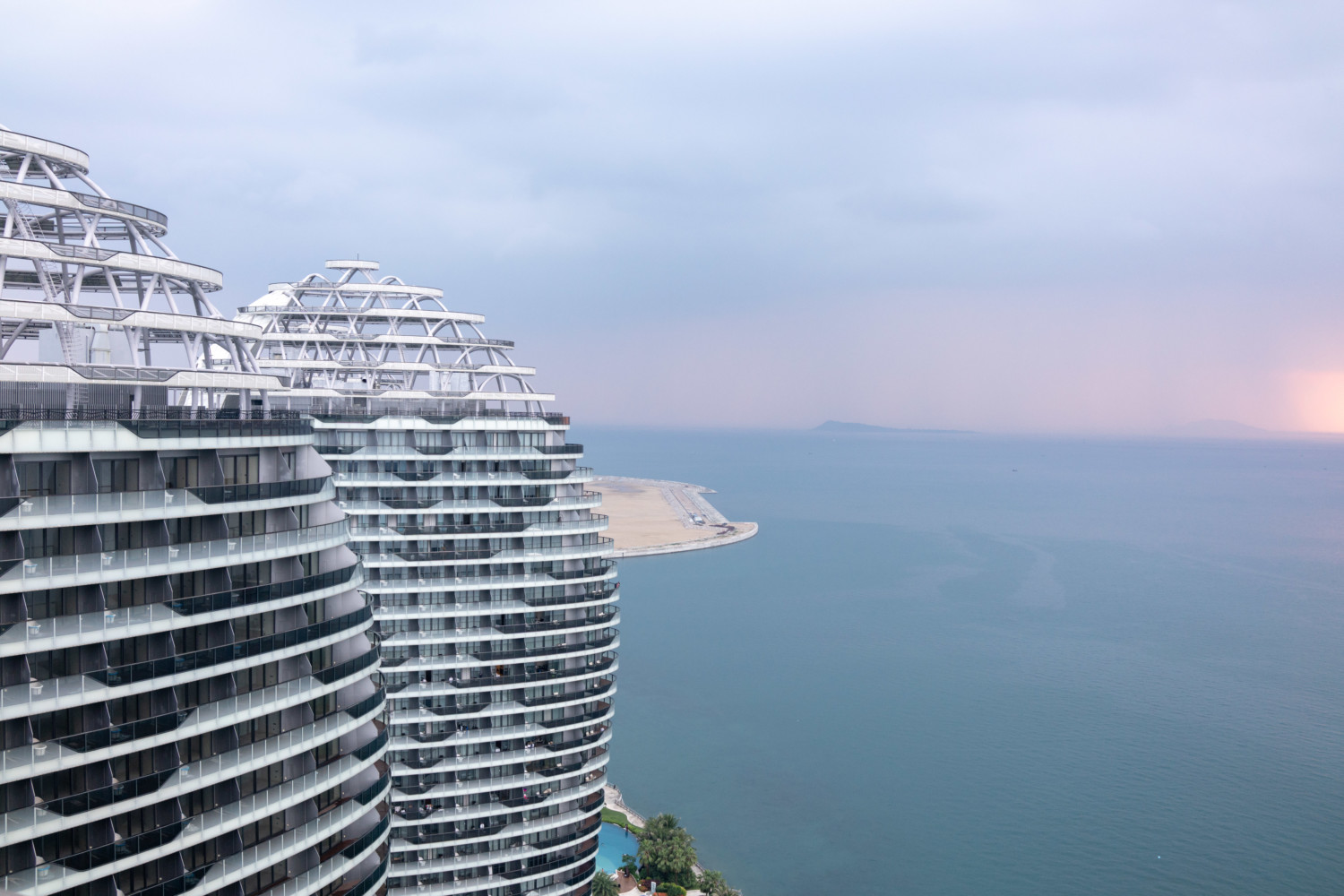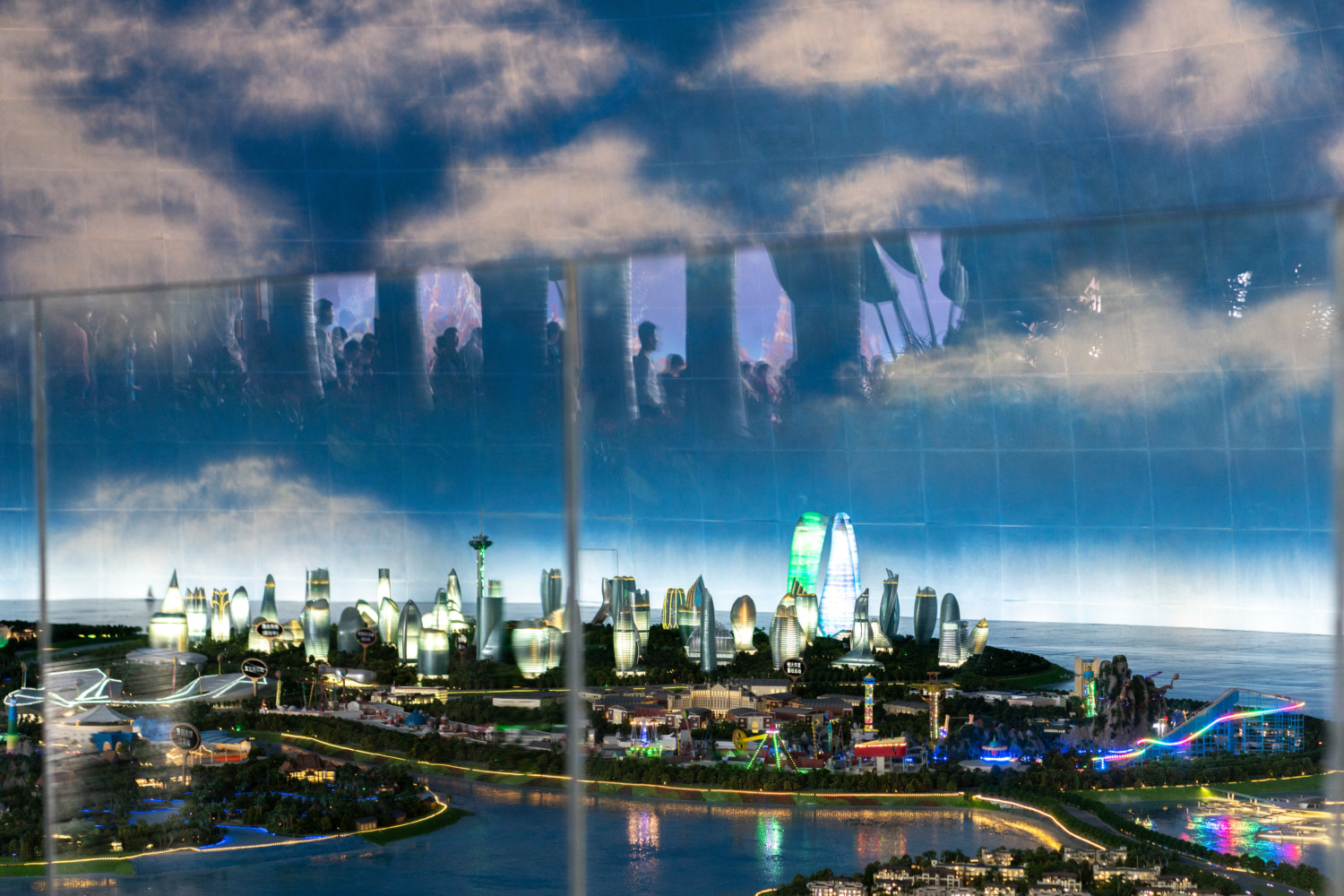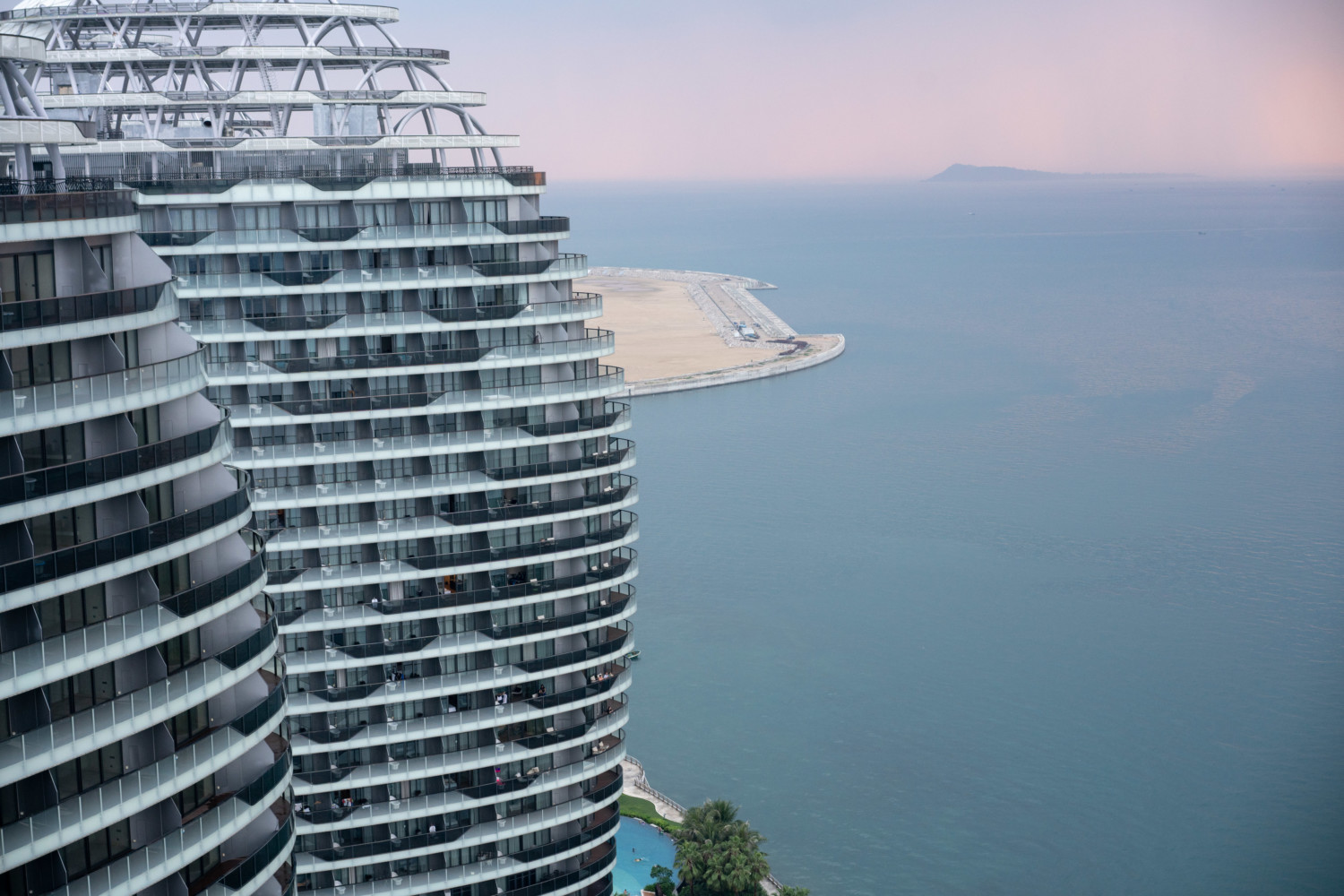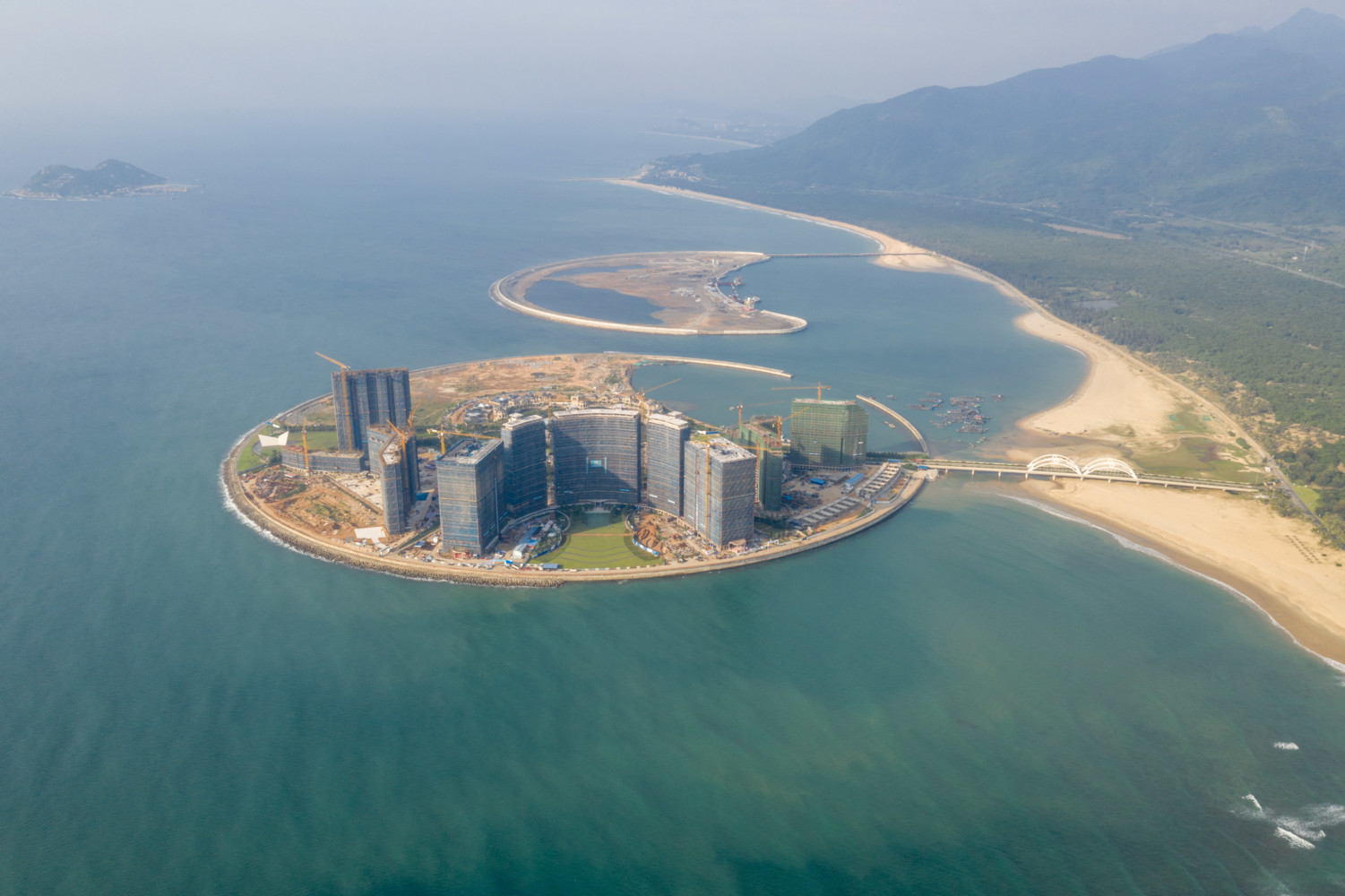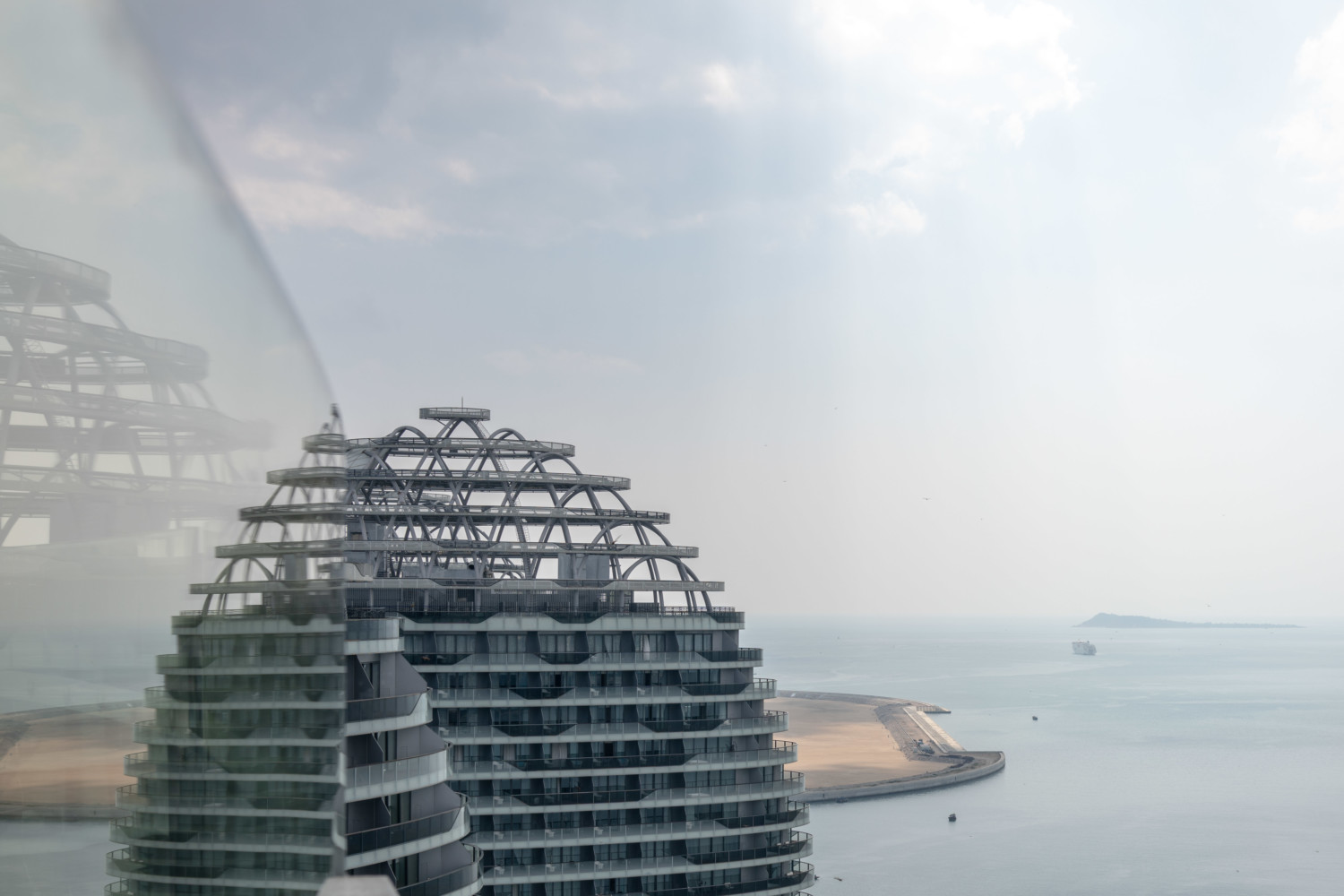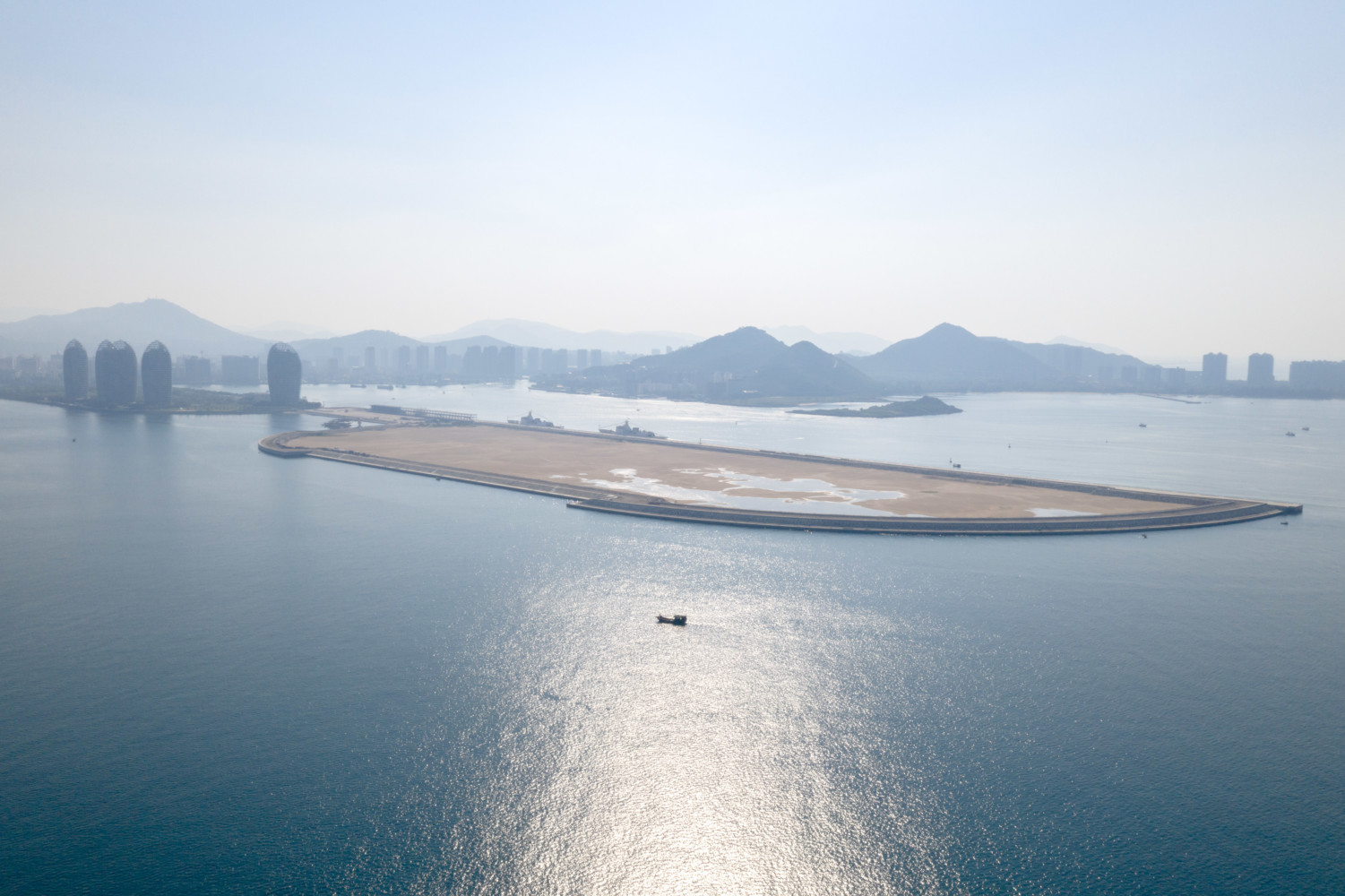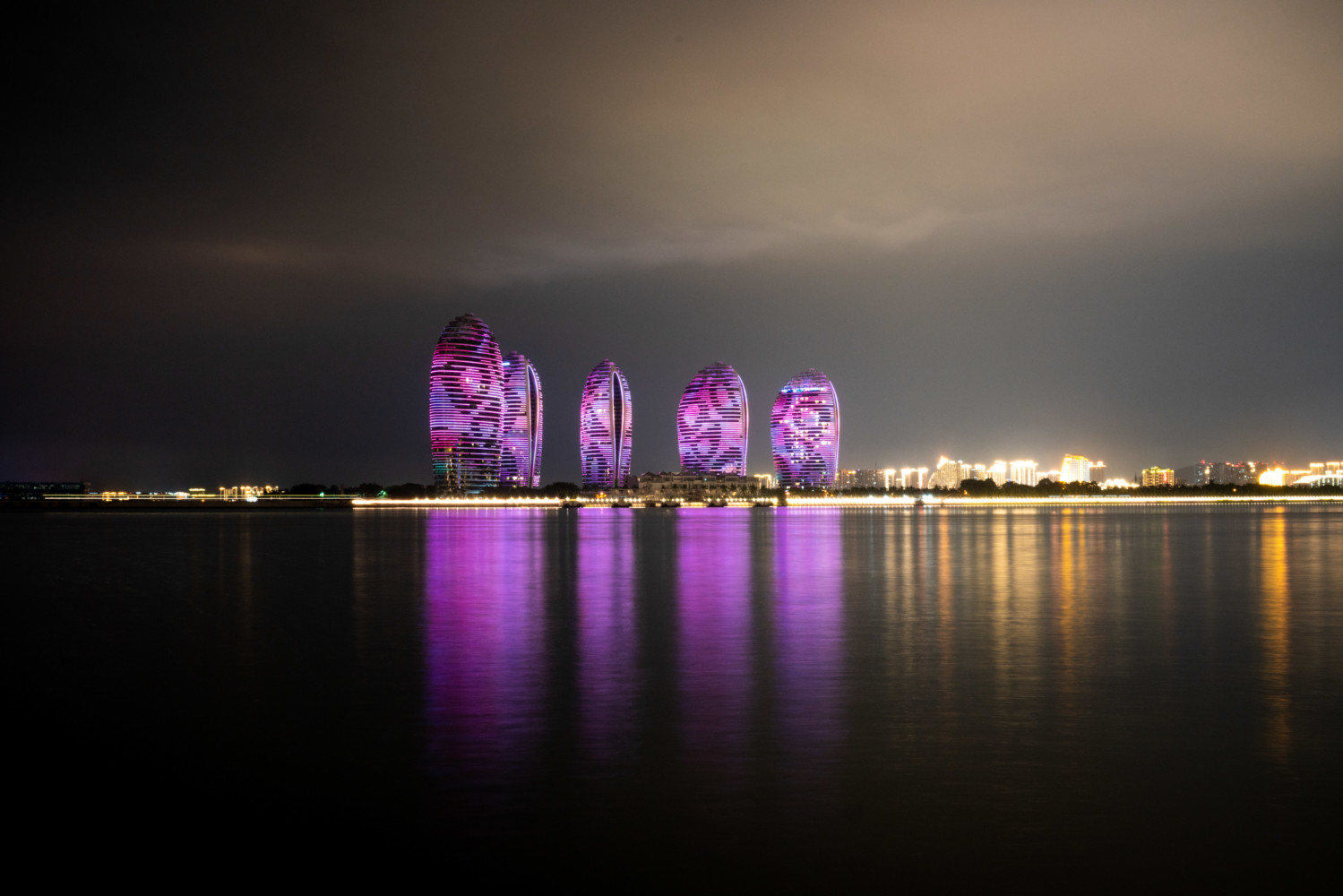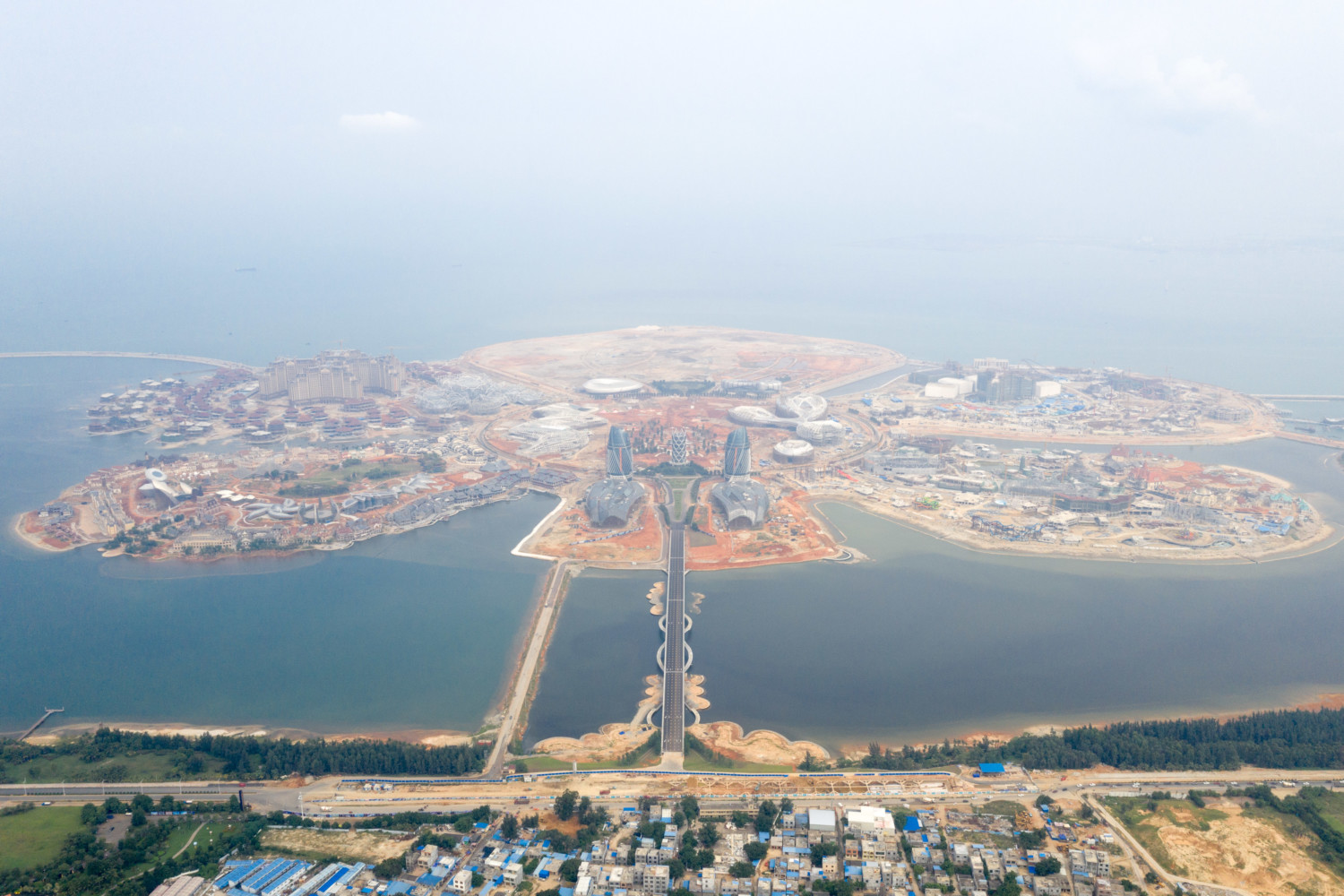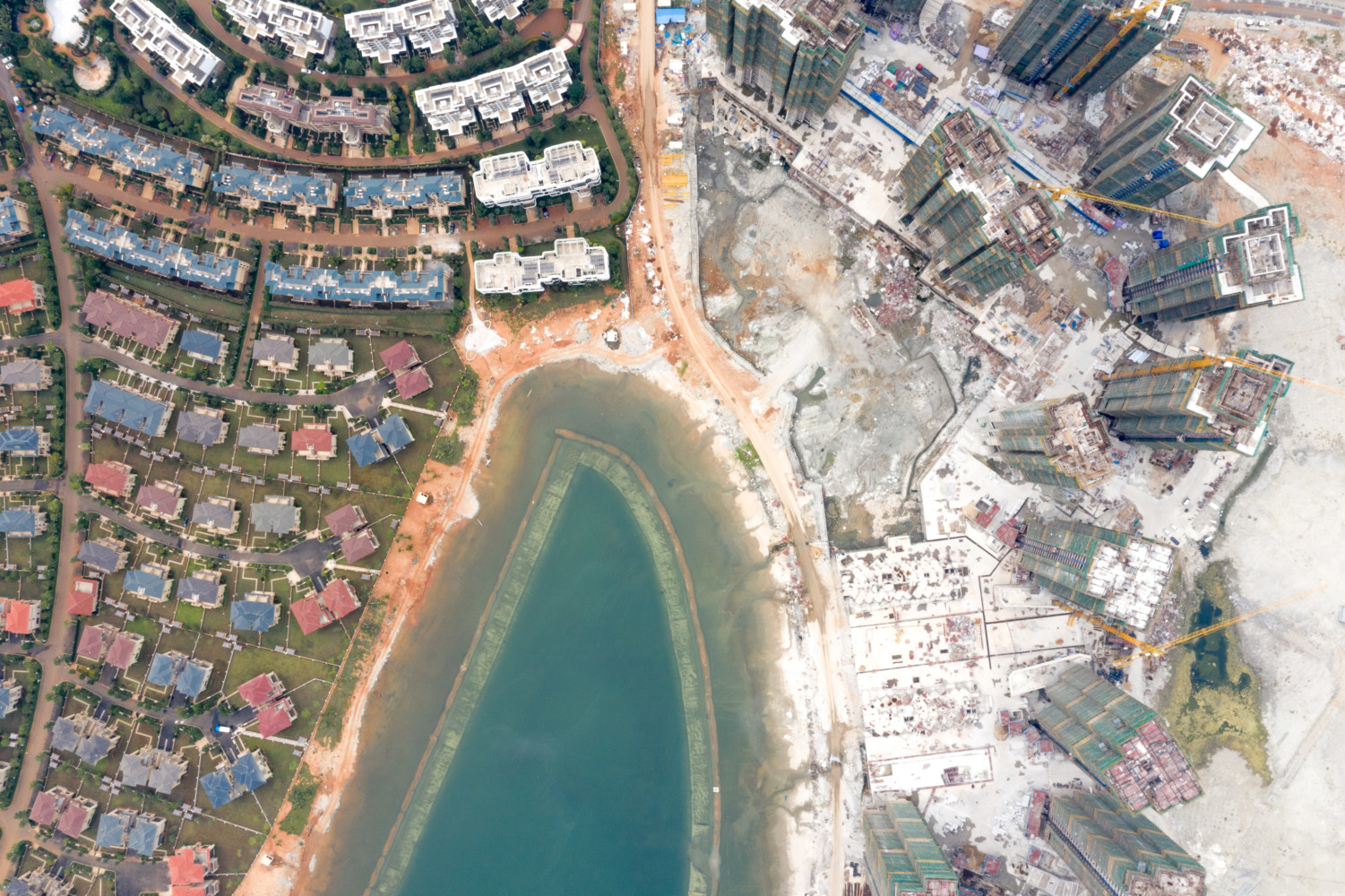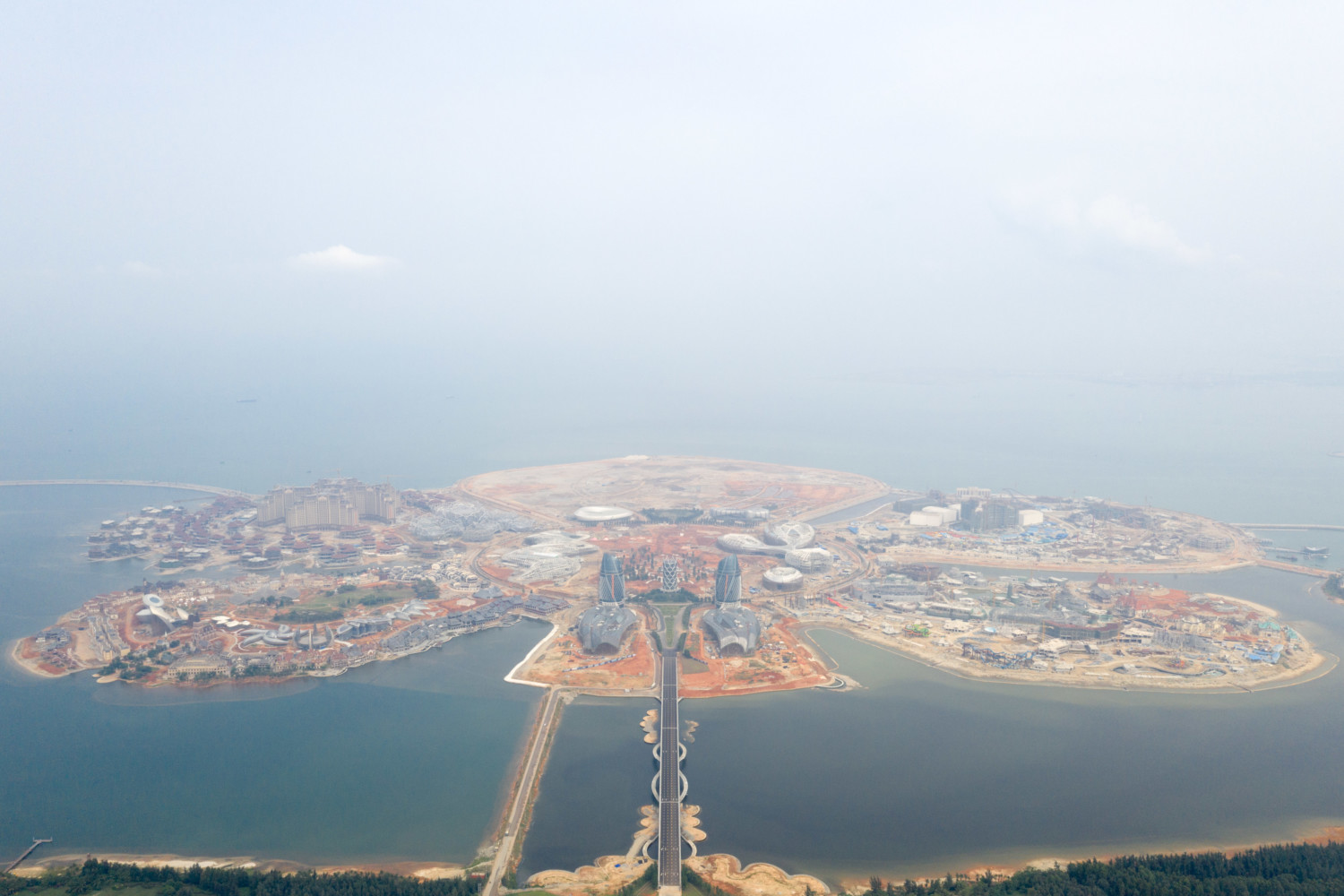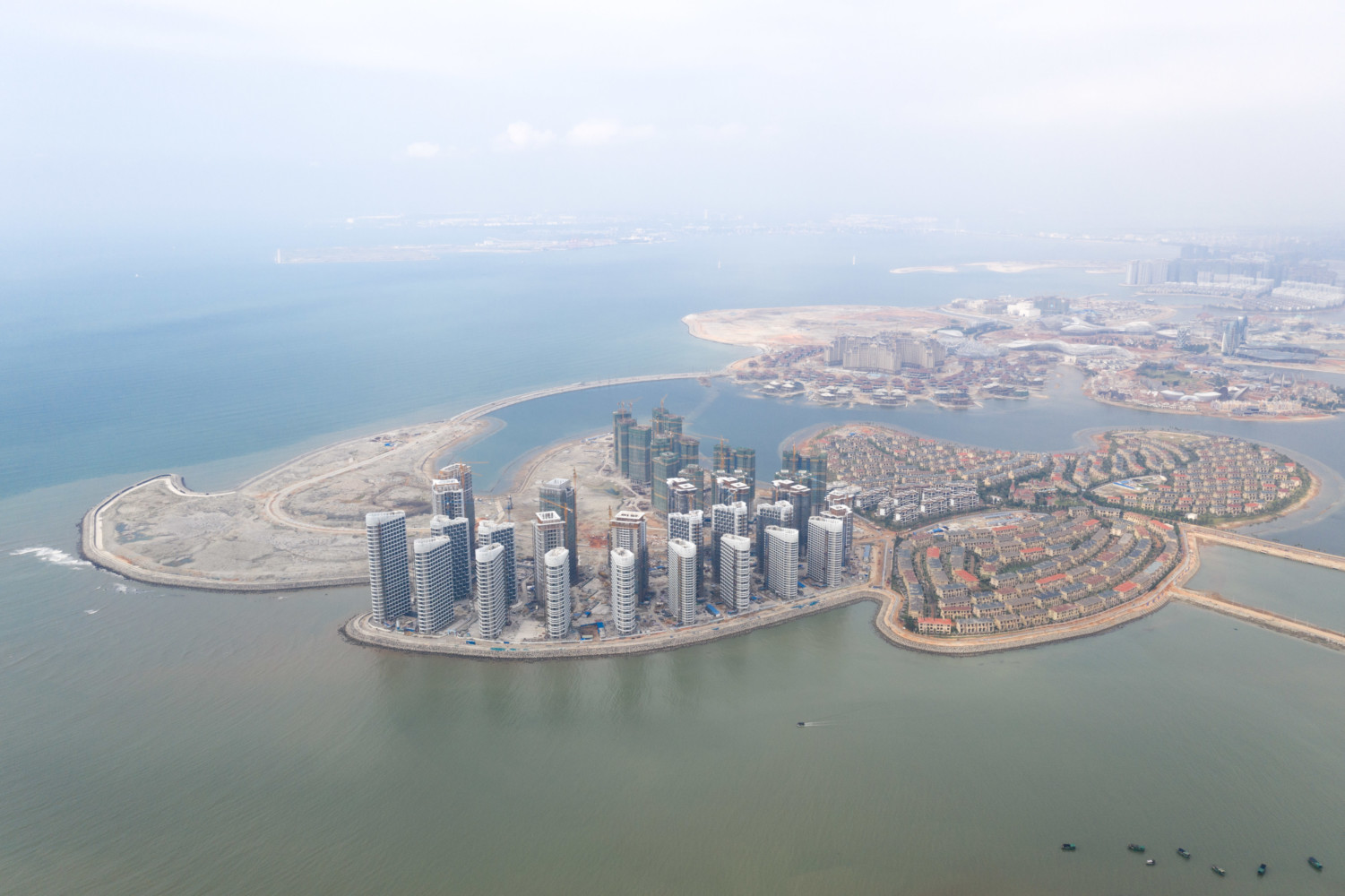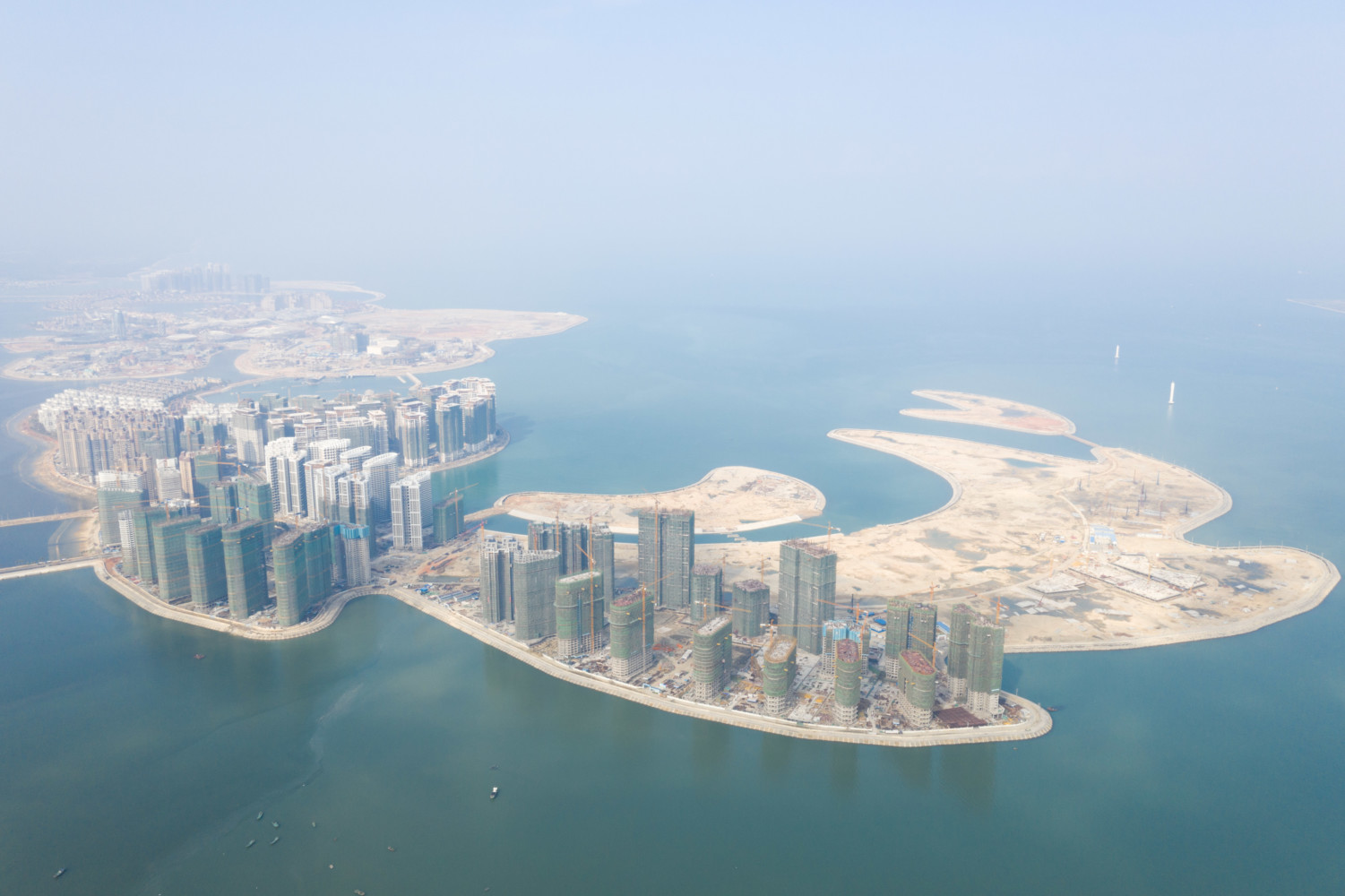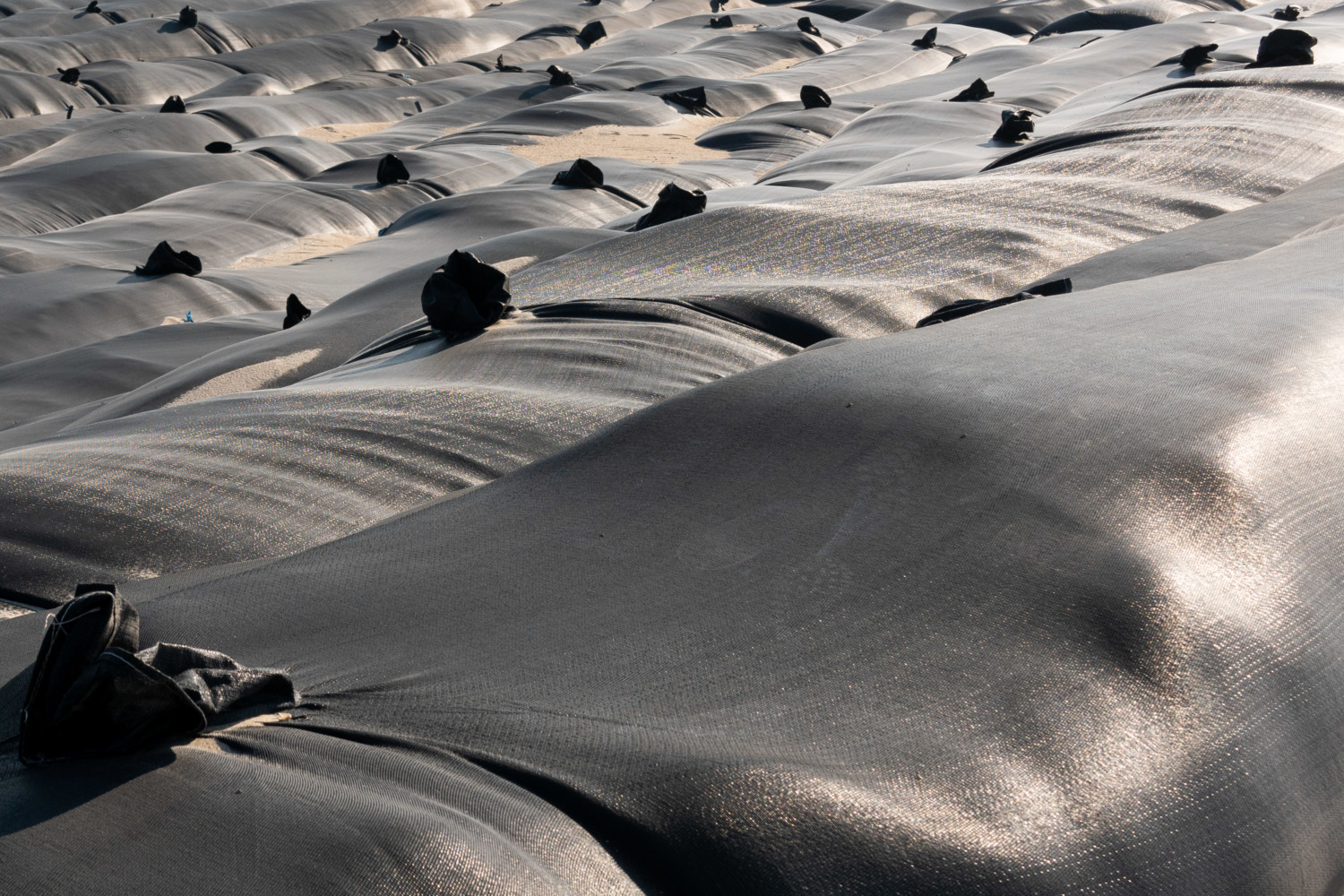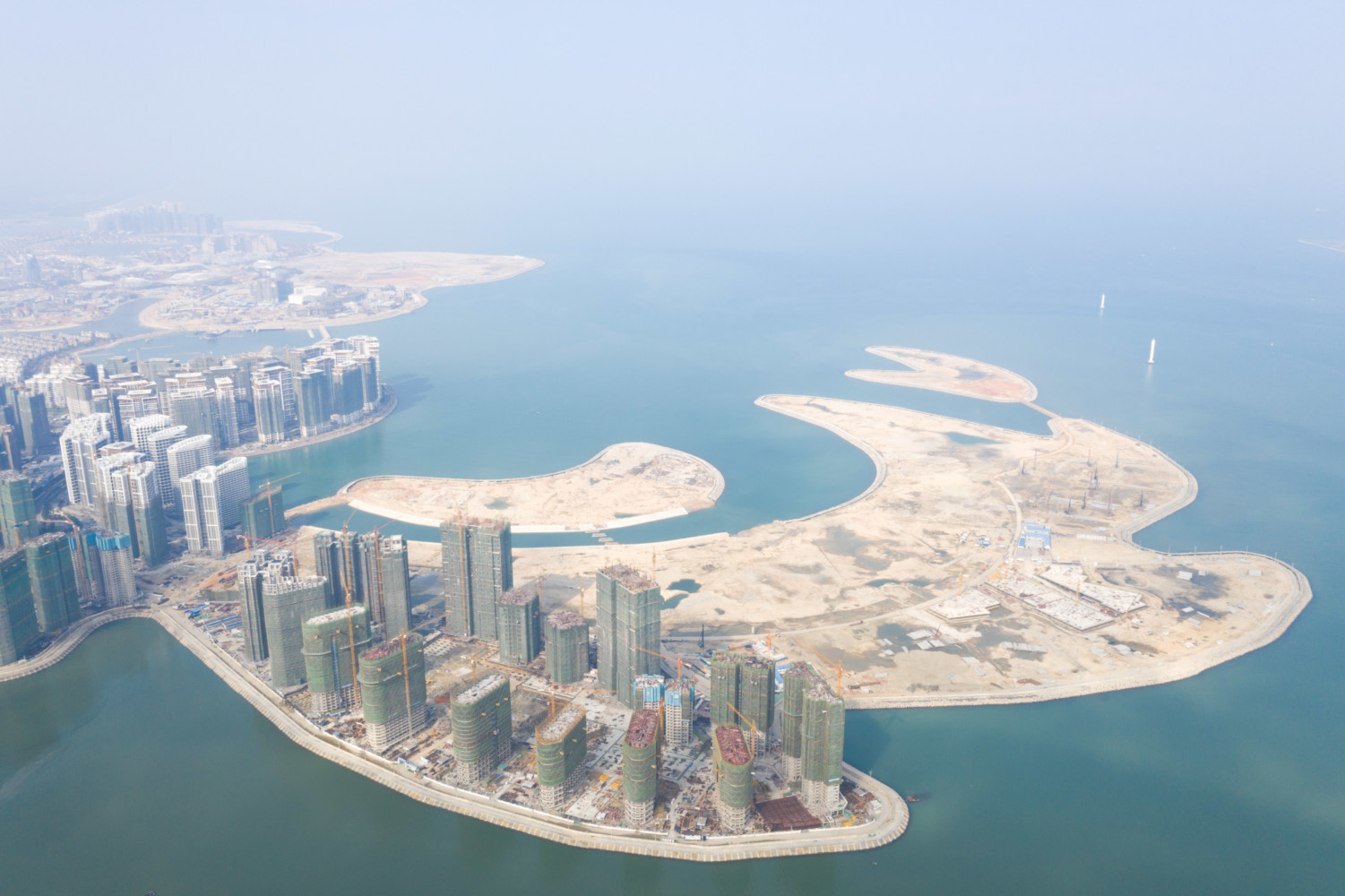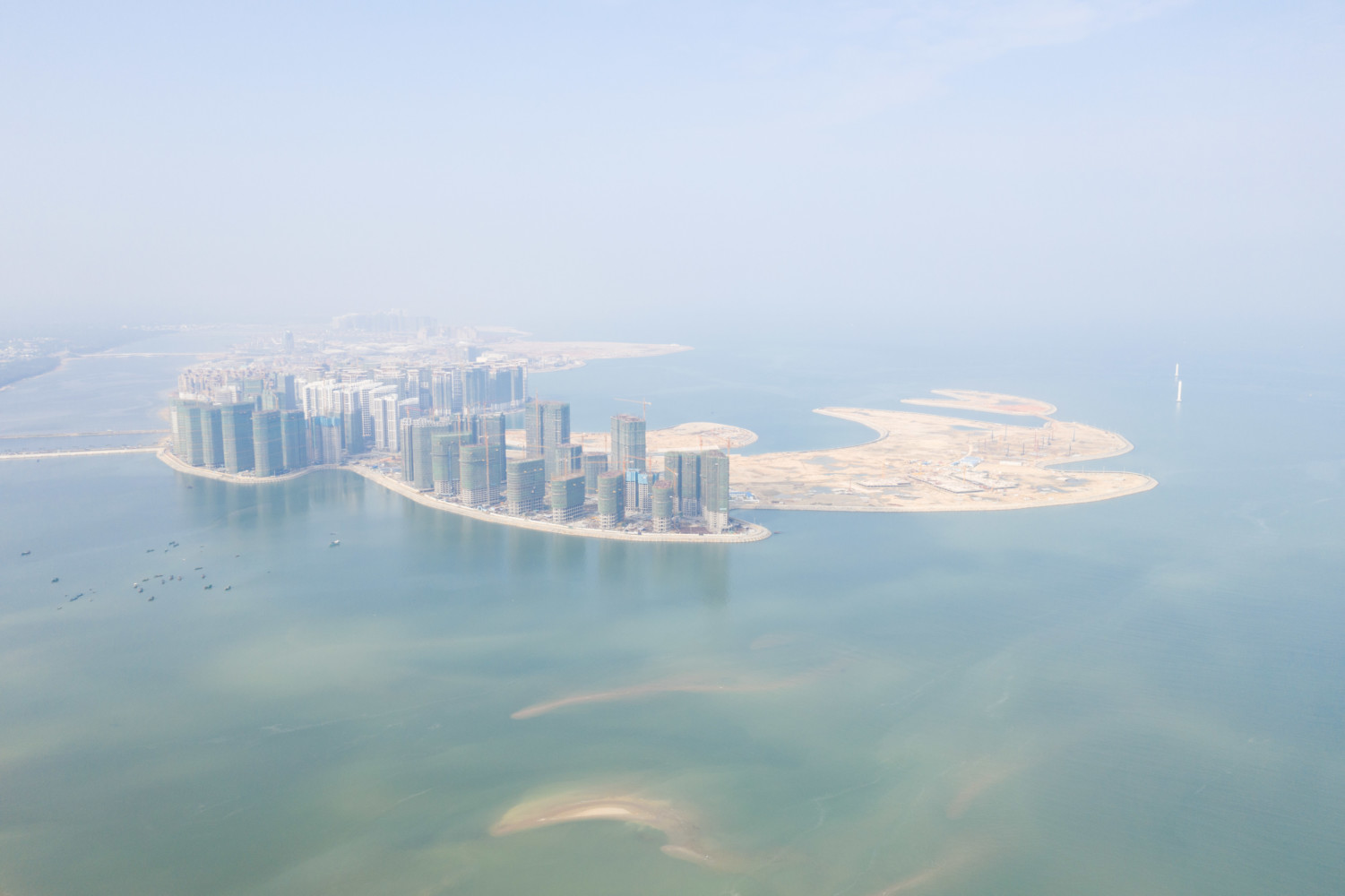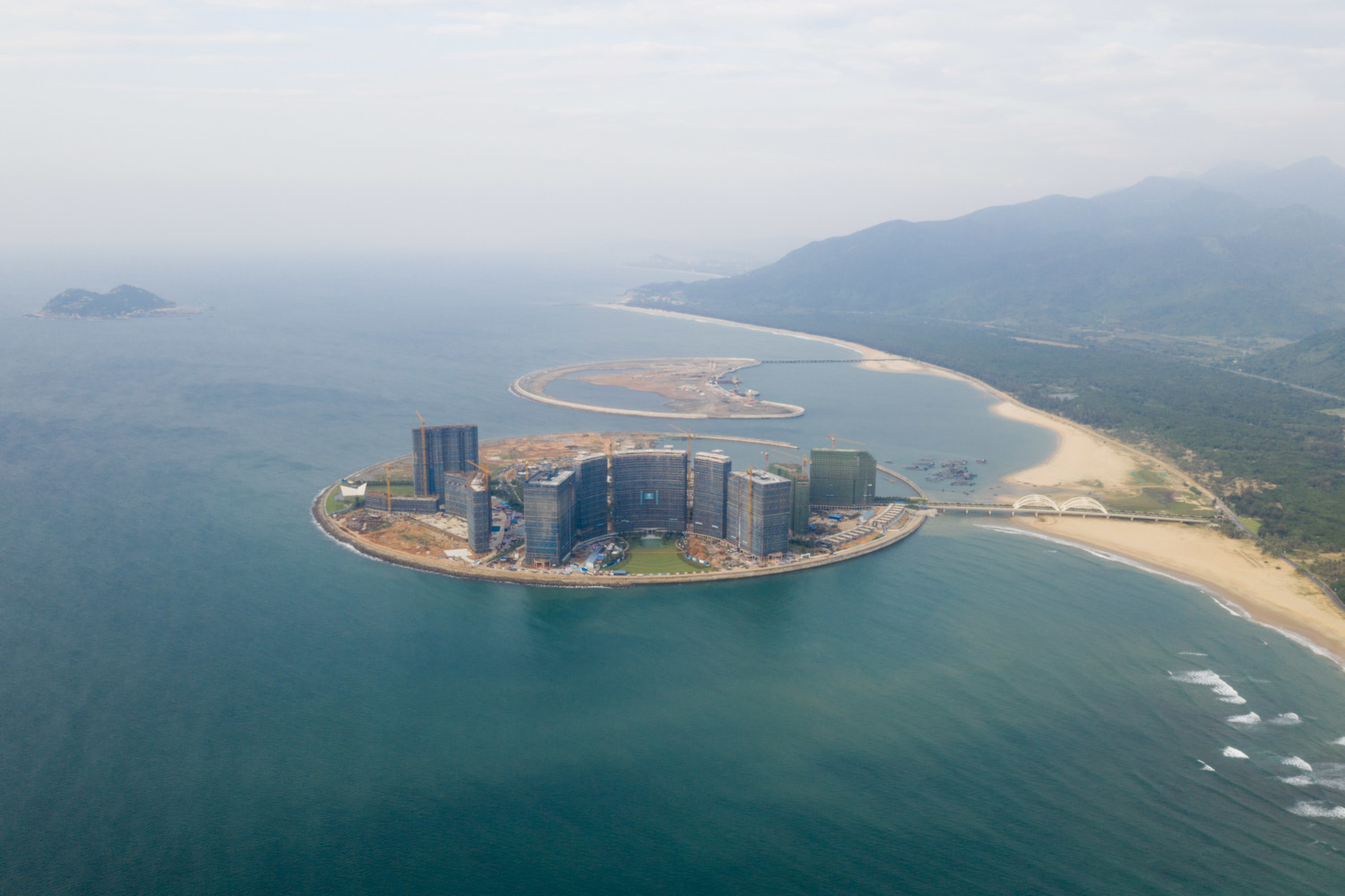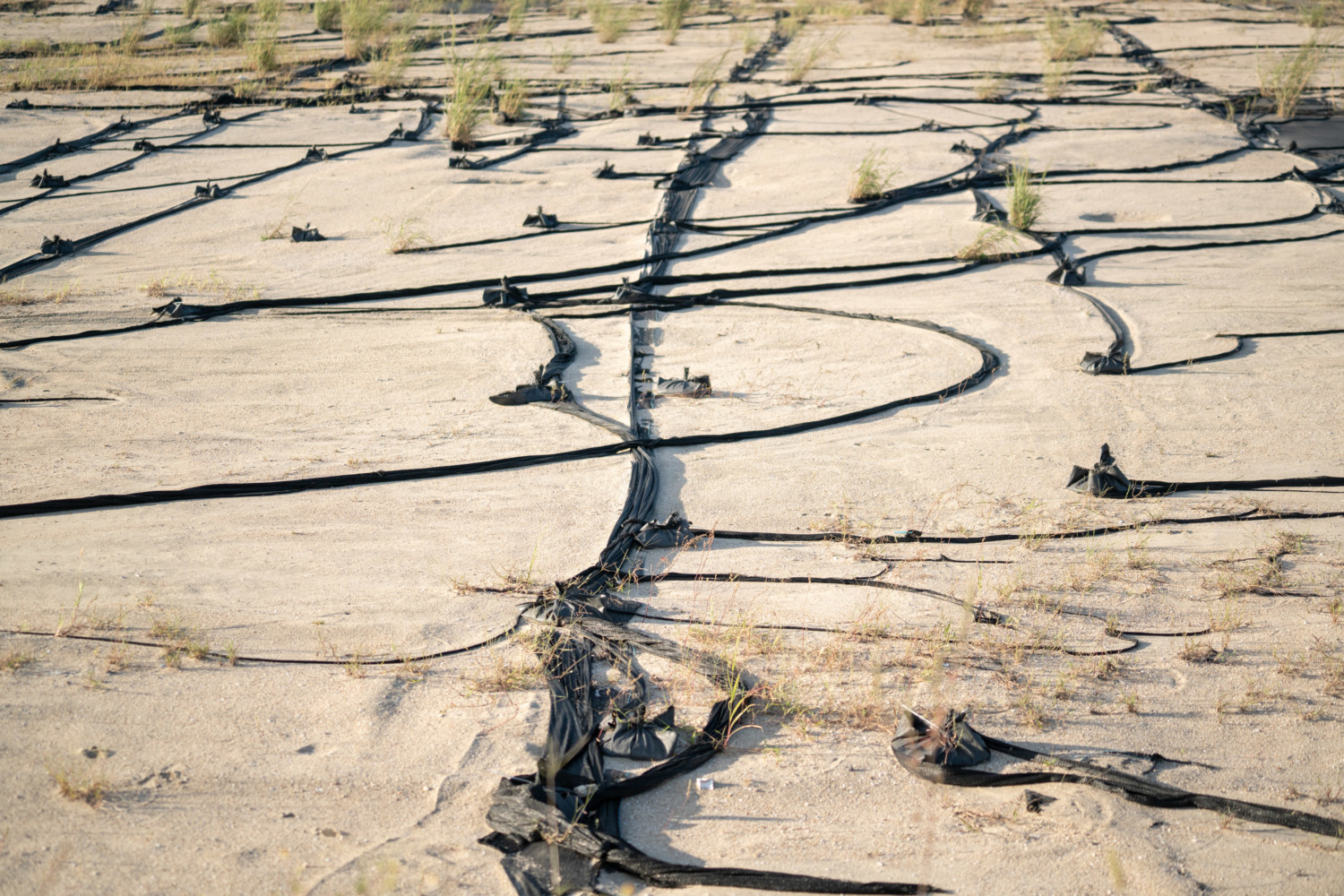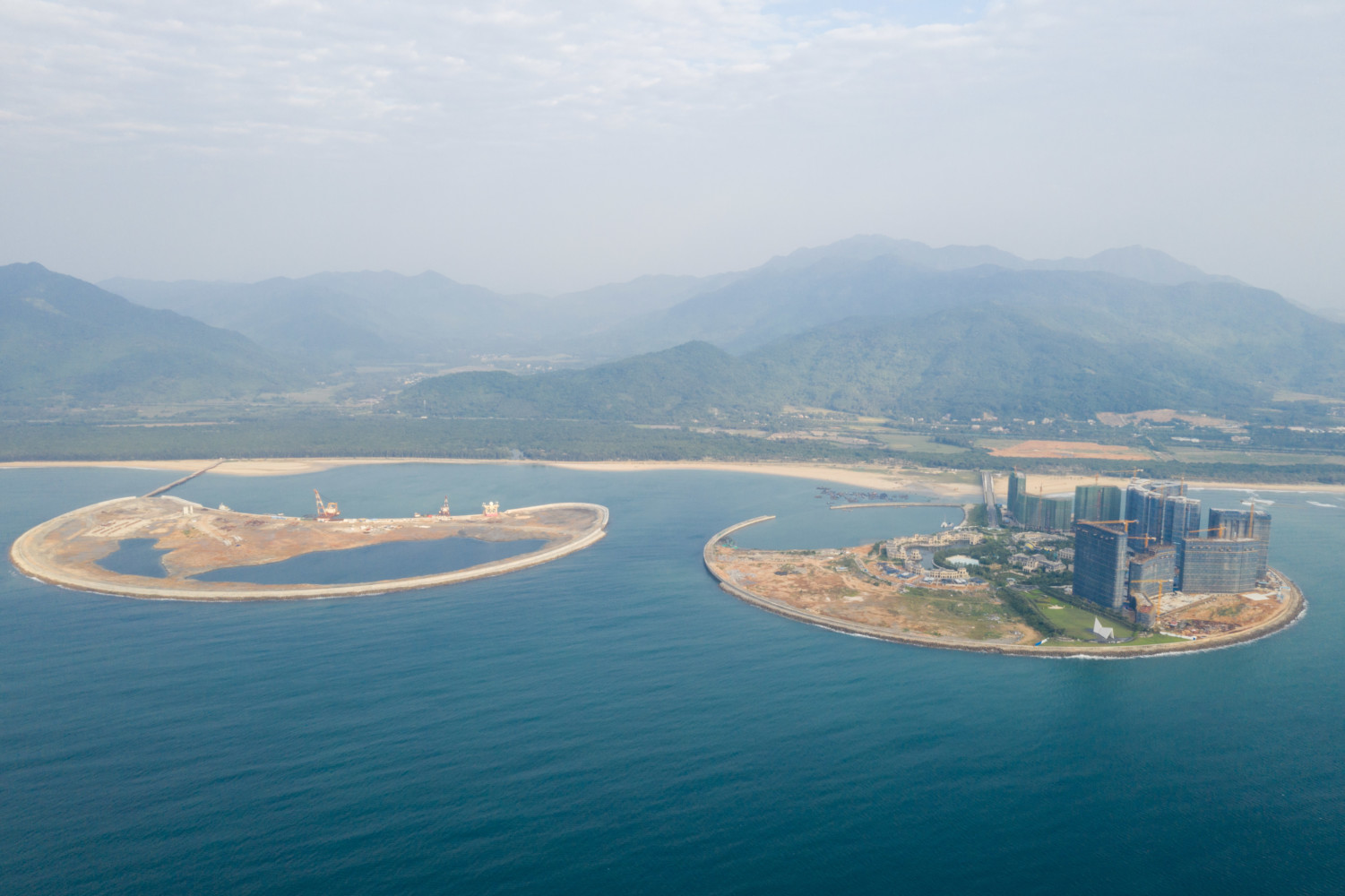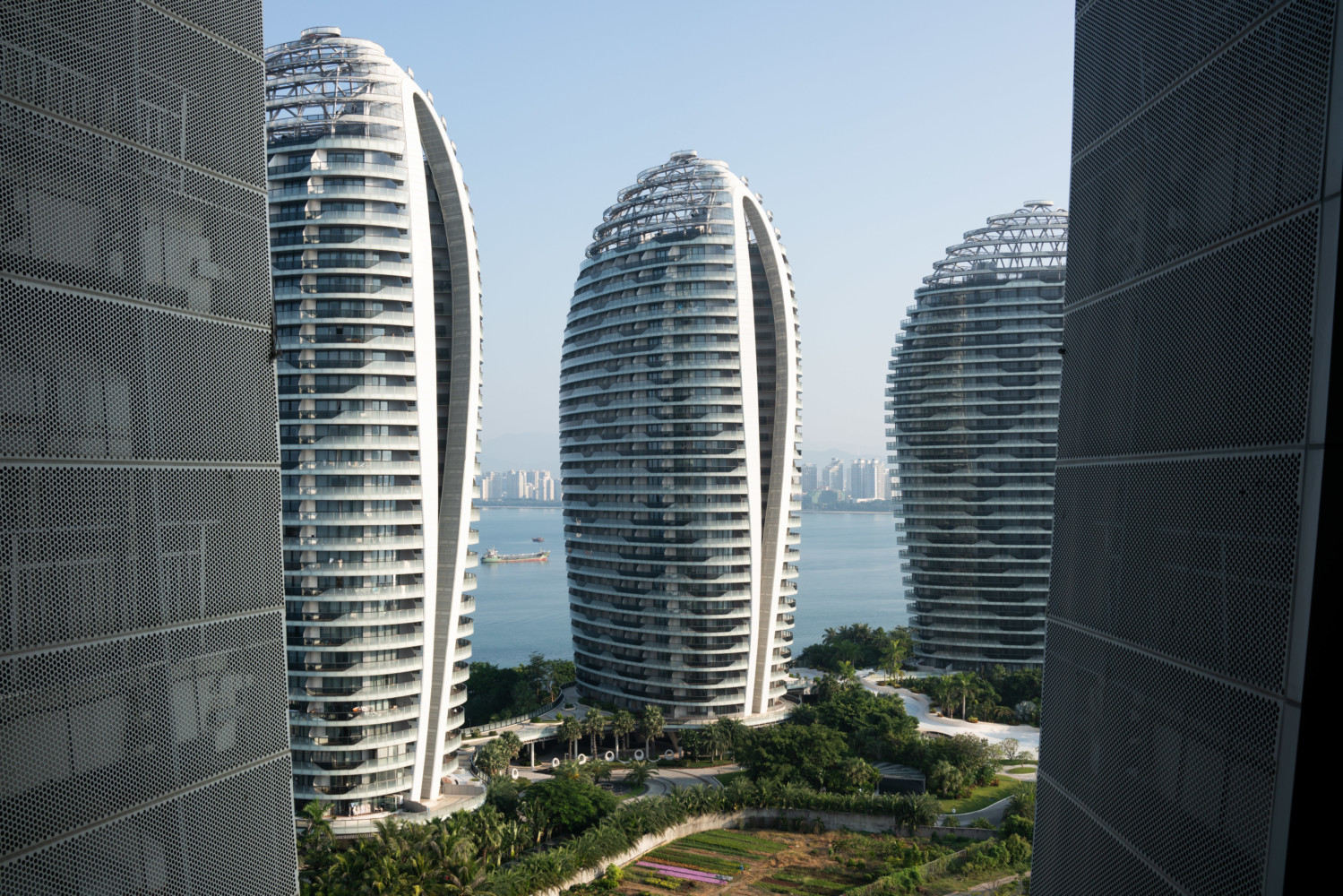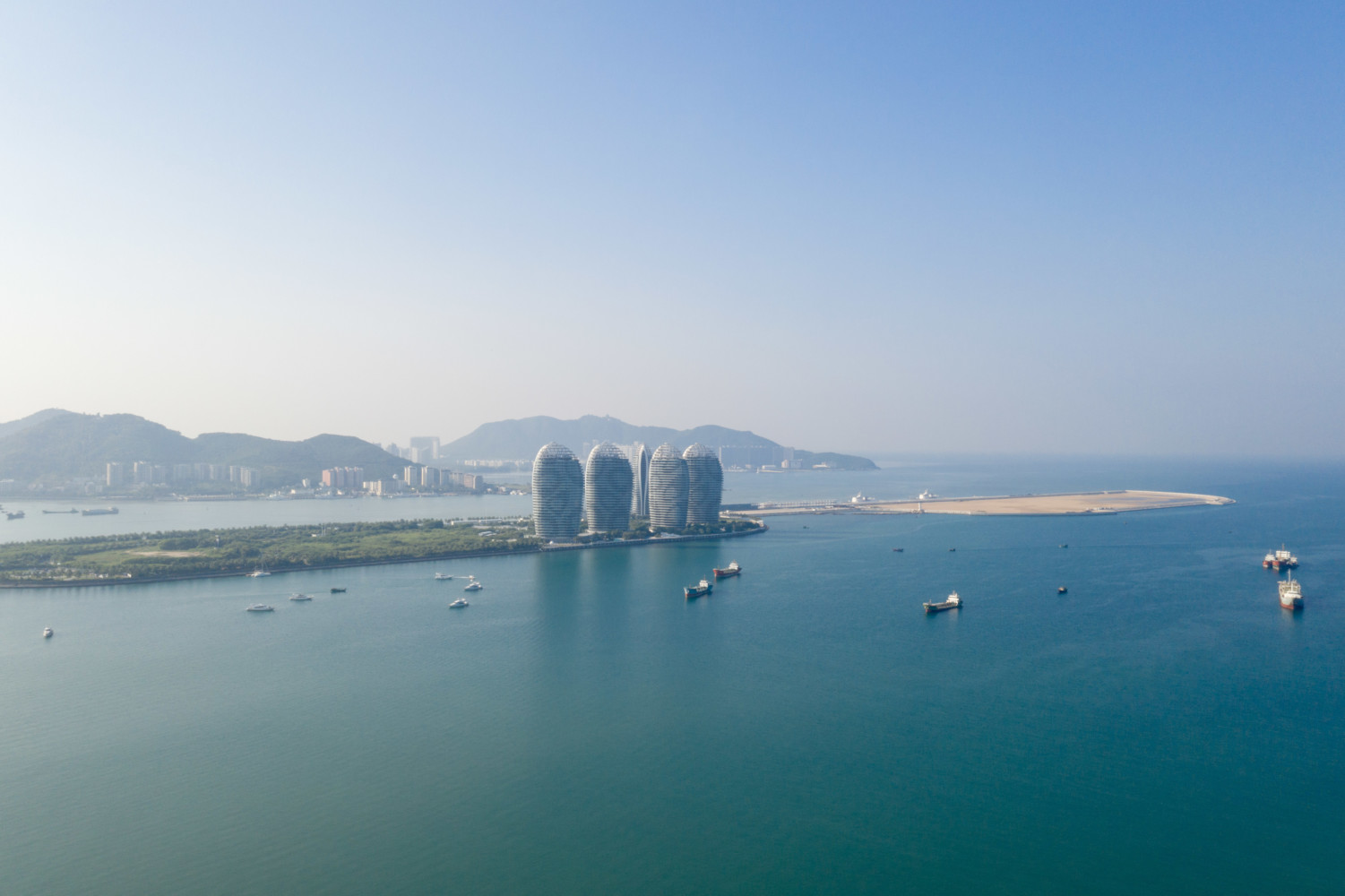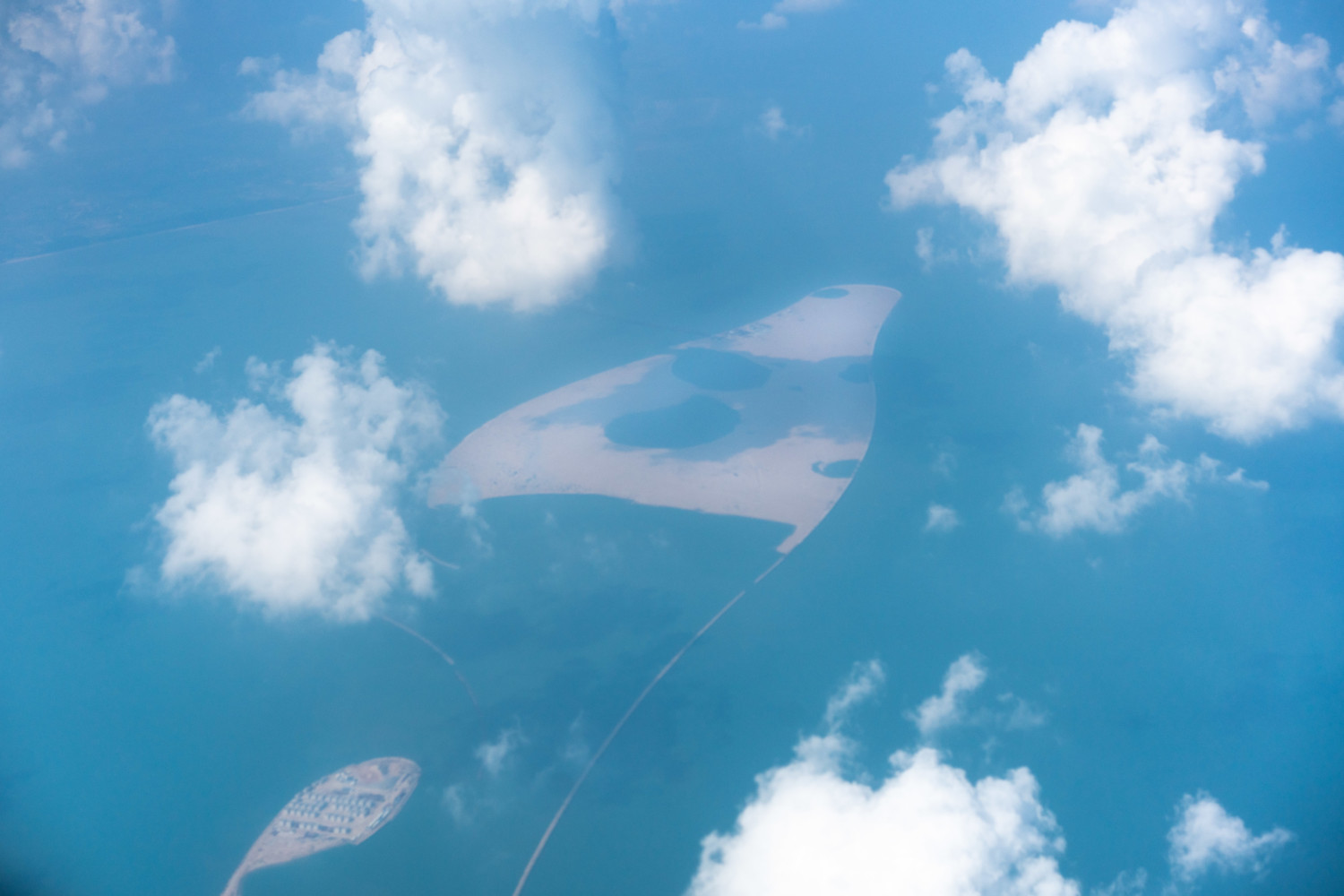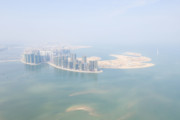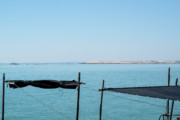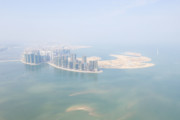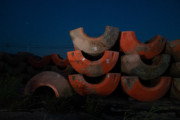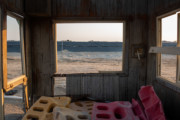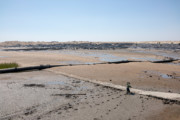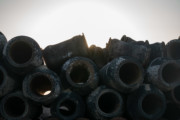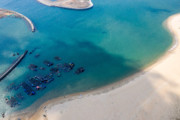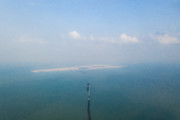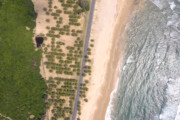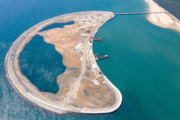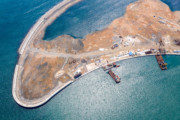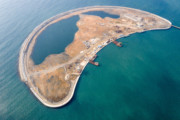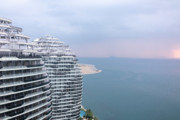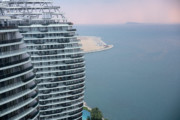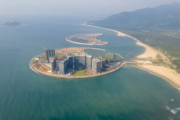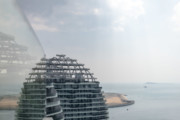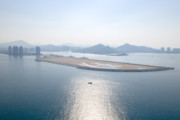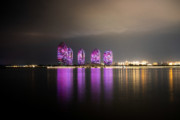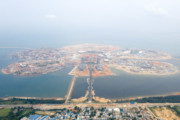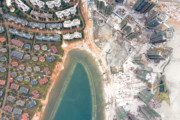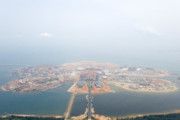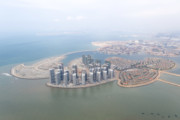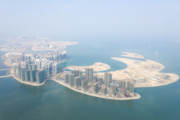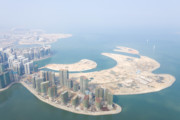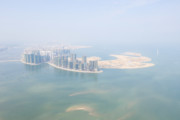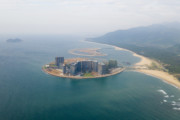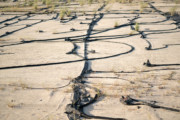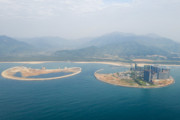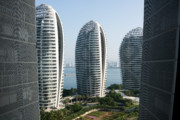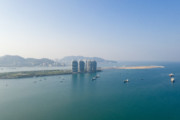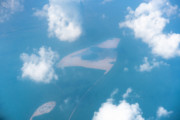Sim Chi Yin A piece of artificial land shimmers in the sun, as seen from traditional fishing boats on a real coast on Dadeng island in Xiamen, southern China. | The prosperous southern coastal city of Xiamen s (...)
tarted in 2016 to reclaim land in preparation to build a controversial second airport on Dadeng Island, a 13 square kilometer island on the border of Xiamen and Kinmen island which belongs to Taiwan.
When the airport is completed on reclaimed land, the size of Dadeng island will have doubled.
The plans are that by 2025, the airport will have two runways, and be able to serve 45 million passengers per year. Right now, highways and subways connecting Xiamen and Dadeng Island are under construction. Although it’s widely reported that the airport is scheduled to be operational by 2020, there is at present no evidence that the central government and the military have given the final approval to the construction of the airport. China. 2018.
| From "Shifting Sands", 2017-on-going. | This project was supported with a grant from the Pulitzer Center for Crisis Reporting. © Sim Chi Yin | Magnum Photos
Sim Chi Yin A heap of pipes probably used for dredging sand lie on a parcel of reclaimed land at the planned site of a new airport in the southern city of Xiamen. | The prosperous southern coastal city of Xiam (...)
en started in 2016 to reclaim land in preparation to build a controversial second airport on Dadeng Island, a 13 square kilometer island on the border of Xiamen and Kinmen island which belongs to Taiwan.
When the airport is completed on reclaimed land, the size of Dadeng island will have doubled.
The plans are that by 2025, the airport will have two runways, and be able to serve 45 million passengers per year. Right now, highways and subways connecting Xiamen and Dadeng Island are under construction. Although it’s widely reported that the airport is scheduled to be operational by 2020, there is at present no evidence that the central government and the military have given the final approval to the construction of the airport. China. 2018.
| From "Shifting Sands", 2017-on-going. | This project was supported with a grant from the Pulitzer Center for Crisis Reporting. © Sim Chi Yin | Magnum Photos
Sim Chi Yin Marketed as the “Dubai of China”, the “Ocean Flower Island” off the coast of Hainan province in China’s far south, is one of several massive land reclamation projects in the country which has raise (...)
d eyebrows and led to China’s strongest crackdown ever against land reclamation in the country this year. Beijing has called for a halt to all unapproved commercial land reclamation projects across the country for environmental impact assessment.
The “Ocean Flower Island” comprises three artificial islands in the sea measuring 7.83 square kilometers, which is 1.4 times the size of Palm Jumeirah, the man-made island in Dubai. Set in the impoverished, industrial city of Danzhou, “Ocean Flower Island” is being sold as a site for sea-front apartments and for tourism. China. 2018. From "Shifting Sands", 2017-on-going. © Sim Chi Yin | Magnum Photos
Sim Chi Yin China. 2018. A line of sand trucks on a parcel of land reclaimed earlier from the sea at the planned site for the new Xiamen airport. | The prosperous southern coastal city of Xiamen started in 201 (...)
6 to reclaim land in preparation to build a controversial second airport on Dadeng Island, a 13 square kilometer island on the border of Xiamen and Kinmen island which belongs to Taiwan.
When the airport is completed on reclaimed land, the size of Dadeng island will have doubled.
The plans are that by 2025, the airport will have two runways, and be able to serve 45 million passengers per year. Right now, highways and subways connecting Xiamen and Dadeng Island are under construction. Although it’s widely reported that the airport is scheduled to be operational by 2020, there is at present no evidence that the central government and the military have given the final approval to the construction of the airport.
| From "Shifting Sands", 2017-on-going. | This project was supported with a grant from the Pulitzer Center for Crisis Reporting. © Sim Chi Yin | Magnum Photos
Sim Chi Yin China. 2018. A heap of floatation devices probably used previously to hold pipes for dredging sand from the sea lie on a parcel of reclaimed land at the planned site of a new airport in the souther (...)
n city of Xiamen. | The prosperous southern coastal city of Xiamen started in 2016 to reclaim land in preparation to build a controversial second airport on Dadeng Island, a 13 square kilometer island on the border of Xiamen and Kinmen island which belongs to Taiwan.
When the airport is completed on reclaimed land, the size of Dadeng island will have doubled.
The plans are that by 2025, the airport will have two runways, and be able to serve 45 million passengers per year. Right now, highways and subways connecting Xiamen and Dadeng Island are under construction. Although it’s widely reported that the airport is scheduled to be operational by 2020, there is at present no evidence that the central government and the military have given the final approval to the construction of the airport.
| From "Shifting Sands", 2017-on-going. | This project was supported with a grant from the Pulitzer Center for Crisis Reporting. © Sim Chi Yin | Magnum Photos
Sim Chi Yin In the background, layers of black bags of sand form a cofferdam -- an enclosure built within a body of water to allow the enclosed area to be pumped out -- on the fringe of a parcel of reclaimed l (...)
and intended for the planned second airport in Xiamen, southern China. | The prosperous southern coastal city of Xiamen started in 2016 to reclaim land in preparation to build a controversial second airport on Dadeng Island, a 13 square kilometer island on the border of Xiamen and Kinmen island which belongs to Taiwan.
When the airport is completed on reclaimed land, the size of Dadeng island will have doubled.
The plans are that by 2025, the airport will have two runways, and be able to serve 45 million passengers per year. Right now, highways and subways connecting Xiamen and Dadeng Island are under construction. Although it’s widely reported that the airport is scheduled to be operational by 2020, there is at present no evidence that the central government and the military have given the final approval to the construction of the airport. China. 2018.
| From "Shifting Sands", 2017-on-going. | This project was supported with a grant from the Pulitzer Center for Crisis Reporting. © Sim Chi Yin | Magnum Photos
Sim Chi Yin In the background, layers of black bags of sand form a cofferdam -- an enclosure built within a body of water to allow the enclosed area to be pumped out -- on the fringe of a parcel of reclaimed l (...)
and intended for the planned second airport in Xiamen, southern China. | The prosperous southern coastal city of Xiamen started in 2016 to reclaim land in preparation to build a controversial second airport on Dadeng Island, a 13 square kilometer island on the border of Xiamen and Kinmen island which belongs to Taiwan.
When the airport is completed on reclaimed land, the size of Dadeng island will have doubled.
The plans are that by 2025, the airport will have two runways, and be able to serve 45 million passengers per year. Right now, highways and subways connecting Xiamen and Dadeng Island are under construction. Although it’s widely reported that the airport is scheduled to be operational by 2020, there is at present no evidence that the central government and the military have given the final approval to the construction of the airport. China. 2018.
| From "Shifting Sands", 2017-on-going. | This project was supported with a grant from the Pulitzer Center for Crisis Reporting. © Sim Chi Yin | Magnum Photos
Sim Chi Yin A heap of pipes probably used for dredging sand lie on a parcel of reclaimed land at the planned site of a new airport in the southern city of Xiamen. | The prosperous southern coastal city of Xiam (...)
en started in 2016 to reclaim land in preparation to build a controversial second airport on Dadeng Island, a 13 square kilometer island on the border of Xiamen and Kinmen island which belongs to Taiwan.
When the airport is completed on reclaimed land, the size of Dadeng island will have doubled.
The plans are that by 2025, the airport will have two runways, and be able to serve 45 million passengers per year. Right now, highways and subways connecting Xiamen and Dadeng Island are under construction. Although it’s widely reported that the airport is scheduled to be operational by 2020, there is at present no evidence that the central government and the military have given the final approval to the construction of the airport. China. 2018.
| From "Shifting Sands", 2017-on-going. | This project was supported with a grant from the Pulitzer Center for Crisis Reporting. © Sim Chi Yin | Magnum Photos
Sim Chi Yin Two islands in the shape of the sun and a crescent moon have been artificially made off Hainan’s east coast, in the Sun and Moon Bay (Riyuewan), a surfing destination 25 km south of Wanning city./ (...)
The two man-made islands make up about 1 square kilometre, and are planned as a tourism site with a theme park, international conference venues, shopping malls, yacht club and luxury hotels.
The land reclamation on the main island — that resembles a round sun — was completed in 2014 and beach erosion was found soon after. The erosion poses a threat to a forest of Vatica mangachapoi which grows on sandy beaches in Hainan. The endangered plant is protected in China as it has already suffered over cutting for its valuable wood.
In addition, the reclamation project will destroy 50,000 sqm coral reef. Chinese press reports say the project started without carrying out a thorough environmental impact assessment.?When these photographs were made in October 2018, construction appeared to still be going on. Italy-based design and architecture firm Metro Studio is listed as being involved in this project. China. 2018.
| From "Shifting Sands", 2017-on-going. | This project was supported with a grant from the Pulitzer Center for Crisis Reporting. © Sim Chi Yin | Magnum Photos
Sim Chi Yin Ruyi island, off Haikou city, was intended as a tourist destination, with theme parks and hotels. Its planned size is over 7 square kilometres and it is to be linked to the mainland through a 5.6 k (...)
m bridge. In an inspection by the authorities in 2017, the project was found to have reclaimed 210,000 sqm of the sea without proper permits. The land reclamation there which started in 2015 has been stopped because of both the environmental inspection as well as the developer running short of funds. In July 2018, Kaisa, another developer has bought the whole Ruyi Island project from its original developer Zhonghong at 1.4 billion rmb. Florida-based landscape architecture company EDSA is listed as being involved in the project. China. 2018.
| From "Shifting Sands", 2017-on-going. | This project was supported with a grant from the Pulitzer Center for Crisis Reporting. |
The Dubai of China
In recent years, China’s coastal provinces — which house most of the country’s population — have been reclaiming land at a rapid pace, artificially creating huge tracts of land where seas, mangrove and wetland once were. Among the fastest-urbanising countries in the world, China has no shortage of useable land, but land reclamation has become seen as a quick and cheap way to get “a blank slate” of land to build on. Reclaimed land usually costs between US$310,000 and $670,000 per hectare. If you compare this cost to the average cost of purchasing land (especially for commercial/residential purposes) in a big city, it’s in some locations at least 10 times more expensive to buy land, than to reclaim.
Since 2006, 13,000 hectares of land (32,123 acres) have been reclaimed on average each year, swallowing up beaches, islands and wetlands. Mangroves which protect the coast and migratory birds’ habitats have been wiped out.
Alarmed by this and its impact on the marine ecosystem, China’s government in January and July last year (2018) slapped a ban on commercial land reclamation. © Sim Chi Yin | Magnum Photos
Sim Chi Yin In recent years, China’s coastal provinces — which house most of the country’s population — have been reclaiming land at a rapid pace, artificially creating huge tracts of land where seas, mangrove (...)
and wetland once were. Among the fastest-urbanising countries in the world, China has no shortage of useable land, but land reclamation has become seen as a quick and cheap way to get “a blank slate” of land to build on. Reclaimed land usually costs between US$310,000 and 670,000 per hectare. If you compare this cost to the average cost of purchasing land (especially for commercial/residential purpose) in a big city, it’s in some locations at least 10 times more expensive to buy land, than to reclaim.
Since 2006, 13,000 hectares of land (32,123 acres) have been reclaimed on average each year, swallowing up beaches, islands and wetlands. Mangroves which protect the coast and migratory birds’ habitats have been wiped out. China. 2018.
Alarmed by this and its impact on the marine ecosystem, China’s government in January and July last year (2018) slapped a ban on commercial land reclamation. Public infrastructure and national defence projects can continue, but many projects by private developers — several proven to be illegal or not officially approved before commencing -- have been suspended, pending investigation or ecological rehabilitation. © Sim Chi Yin | Magnum Photos
Sim Chi Yin China. 2018. Two islands in the shape of the sun and a crescent moon have been artificially made off Hainan’s east coast, in the Sun and Moon Bay (Riyuewan), a surfing destination 25 km south of Wa (...)
nning city./ The two man-made islands make up about 1 square kilometre, and are planned as a tourism site with a theme park, international conference venues, shopping malls, yacht club and luxury hotels.
The land reclamation on the main island — that resembles a round sun — was completed in 2014 and beach erosion was found soon after. The erosion poses a threat to a forest of Vatica mangachapoi which grows on sandy beaches in Hainan. The endangered plant is protected in China as it has already suffered over cutting for its valuable wood.
In addition, the reclamation project will destroy 50,000 sqm coral reef. Chinese press reports say the project started without carrying out a thorough environmental impact assessment.?When these photographs were made in October 2018, construction appeared to still be going on. Italy-based design and architecture firm Metro Studio is listed as being involved in this project.
| From "Shifting Sands", 2017-on-going. | This project was supported with a grant from the Pulitzer Center for Crisis Reporting. © Sim Chi Yin | Magnum Photos
Sim Chi Yin China. 2018. Two islands in the shape of the sun and a crescent moon have been artificially made off Hainan’s east coast, in the Sun and Moon Bay (Riyuewan), a surfing destination 25 km south of Wa (...)
nning city./ The two man-made islands make up about 1 square kilometre, and are planned as a tourism site with a theme park, international conference venues, shopping malls, yacht club and luxury hotels.
The land reclamation on the main island — that resembles a round sun — was completed in 2014 and beach erosion was found soon after. The erosion poses a threat to a forest of Vatica mangachapoi which grows on sandy beaches in Hainan. The endangered plant is protected in China as it has already suffered over cutting for its valuable wood.
In addition, the reclamation project will destroy 50,000 sqm coral reef. Chinese press reports say the project started without carrying out a thorough environmental impact assessment.?When these photographs were made in October 2018, construction appeared to still be going on. Italy-based design and architecture firm Metro Studio is listed as being involved in this project.
| From "Shifting Sands", 2017-on-going. | This project was supported with a grant from the Pulitzer Center for Crisis Reporting. © Sim Chi Yin | Magnum Photos
Sim Chi Yin China. 2018. Two islands in the shape of the sun and a crescent moon have been artificially made off Hainan’s east coast, in the Sun and Moon Bay (Riyuewan), a surfing destination 25 km south of Wa (...)
nning city./ The two man-made islands make up about 1 square kilometre, and are planned as a tourism site with a theme park, international conference venues, shopping malls, yacht club and luxury hotels.
The land reclamation on the main island — that resembles a round sun — was completed in 2014 and beach erosion was found soon after. The erosion poses a threat to a forest of Vatica mangachapoi which grows on sandy beaches in Hainan. The endangered plant is protected in China as it has already suffered over cutting for its valuable wood.
In addition, the reclamation project will destroy 50,000 sqm coral reef. Chinese press reports say the project started without carrying out a thorough environmental impact assessment.?When these photographs were made in October 2018, construction appeared to still be going on. Italy-based design and architecture firm Metro Studio is listed as being involved in this project.
| From "Shifting Sands", 2017-on-going. | This project was supported with a grant from the Pulitzer Center for Crisis Reporting. © Sim Chi Yin | Magnum Photos
Sim Chi Yin A view from on Phoenix island, Sanya, Hainan. Phoenix Island, on the resort city of Sanya, was the Hainan island’s first flagship land reclamation mega project, attracting internationally renowned (...)
architects. Reclaimed between 2002 and 2003, and opened for business in 2015, the artificial island in Sanya Bay has luxury apartments, hotels and a cruise centre — all a short distance from the centre of the city. A second phase of reclamation was undertaken in 2014 — seen here as the empty, sandy plot — bringing the total size of the island to 0.84 square kilometers. But this was found to have led to the erosion of over 2km of Sanya Bay’s coast. Following an environmental inspection in late 2017, the government has slapped a suspension on further construction as the project was found to have impacted coastal erosion and the ecosystem, and caused sedimentation at the mouth of the Sanya River. Companies involved in this project include New York-based Balmori Associates, which does landscape and urban design, and the brand-name Chinese architect Ma Yansong's firm MAD. China. 2018. | From "Shifting Sands", 2017-on-going. | This project was supported with a grant from the Pulitzer Center for Crisis Reporting. © Sim Chi Yin | Magnum Photos
Sim Chi Yin China. 2018. At a showroom for the "Ocean Flower Island" property development. The Dubais of China |
Marketed as the “Dubai of China”, the “Ocean Flower Island” off the coast of Hainan province i (...)
n China’s far south, is one of several massive land reclamation projects in the country which has raised eyebrows and led to China’s strongest crackdown ever against land reclamation in the country this year. Beijing has called for a halt to all unapproved commercial land reclamation projects across the country for environmental impact assessment.
The “Ocean Flower Island” comprises three artificial islands in the sea measuring 7.83 square kilometers, which is 1.4 times the size of Palm Jumeirah, the man-made island in Dubai. Set in the impoverished, industrial city of Danzhou, “Ocean Flower Island” is being sold as a site for sea-front apartments and for tourism. For the project, the company behind it, Evergrande — China’s largest property developer — was found to have dredged sand illegally, used land illegally and not followed the legal processes for land-use approval. But after government inspections, the company pledged 300 million yuan to help the area’s ecology recover, and construction has restarted again. Among the foreign companies listed as involved in the Ocean Flower project are Hilton hotels, Chicago-based Saltan Architects, ThemeParX, a global theme park consultancy. | This latest chapter of this on-going project was supported by Magnum and Pulitzer Center for Crisis Reporting. | The Dubai of China
In recent years, China’s coastal provinces — which house most of the country’s population — have been reclaiming land at a rapid pace, artificially creating huge tracts of land where seas, mangrove and wetland once were. Among the fastest-urbanising countries in the world, China has no shortage of useable land, but land reclamation has become seen as a quick and cheap way to get “a blank slate” of land to build on. Reclaimed land usua © Sim Chi Yin | Magnum Photos
Sim Chi Yin China. 2018. A view from on Phoenix island, Sanya, Hainan. Phoenix Island, on the resort city of Sanya, was the Hainan island’s first flagship land reclamation mega project, attracting internationa (...)
lly renowned architects. Reclaimed between 2002 and 2003, and opened for business in 2015, the artificial island in Sanya Bay has luxury apartments, hotels and a cruise centre — all a short distance from the centre of the city. A second phase of reclamation was undertaken in 2014 — seen here as the empty, sandy plot — bringing the total size of the island to 0.84 square kilometers. But this was found to have led to the erosion of over 2km of Sanya Bay’s coast. Following an environmental inspection in late 2017, the government has slapped a suspension on further construction as the project was found to have impacted coastal erosion and the ecosystem, and caused sedimentation at the mouth of the Sanya River. Companies involved in this project include New York-based Balmori Associates, which does landscape and urban design, and the brand-name Chinese architect Ma Yansong's firm MAD. | From "Shifting Sands", 2017-on-going. | This project was supported with a grant from the Pulitzer Center for Crisis Reporting. © Sim Chi Yin | Magnum Photos
Sim Chi Yin Two islands in the shape of the sun and a crescent moon have been artificially made off Hainan’s east coast, in the Sun and Moon Bay (Riyuewan), a surfing destination 25 km south of Wanning city./ (...)
The two man-made islands make up about 1 square kilometre, and are planned as a tourism site with a theme park, international conference venues, shopping malls, yacht club and luxury hotels.
The land reclamation on the main island — that resembles a round sun — was completed in 2014 and beach erosion was found soon after. The erosion poses a threat to a forest of Vatica mangachapoi which grows on sandy beaches in Hainan. The endangered plant is protected in China as it has already suffered over cutting for its valuable wood.
In addition, the reclamation project will destroy 50,000 sqm coral reef. Chinese press reports say the project started without carrying out a thorough environmental impact assessment.?When these photographs were made in October 2018, construction appeared to still be going on. Italy-based design and architecture firm Metro Studio is listed as being involved in this project. China. 2018.
| From "Shifting Sands", 2017-on-going. | This project was supported with a grant from the Pulitzer Center for Crisis Reporting. © Sim Chi Yin | Magnum Photos
Sim Chi Yin China. 2018. A view from on Phoenix island, Sanya, Hainan. Phoenix Island, on the resort city of Sanya, was the Hainan island’s first flagship land reclamation mega project, attracting internationa (...)
lly renowned architects. Reclaimed between 2002 and 2003, and opened for business in 2015, the artificial island in Sanya Bay has luxury apartments, hotels and a cruise centre — all a short distance from the centre of the city. A second phase of reclamation was undertaken in 2014 — seen here as the empty, sandy plot — bringing the total size of the island to 0.84 square kilometers. But this was found to have led to the erosion of over 2km of Sanya Bay’s coast. Following an environmental inspection in late 2017, the government has slapped a suspension on further construction as the project was found to have impacted coastal erosion and the ecosystem, and caused sedimentation at the mouth of the Sanya River. Companies involved in this project include New York-based Balmori Associates, which does landscape and urban design, and the brand-name Chinese architect Ma Yansong's firm MAD. | From "Shifting Sands", 2017-on-going. | This project was supported with a grant from the Pulitzer Center for Crisis Reporting. © Sim Chi Yin | Magnum Photos
Sim Chi Yin A view from on Phoenix island, Sanya, Hainan. Phoenix Island, on the resort city of Sanya, was the Hainan island’s first flagship land reclamation mega project, attracting internationally renowned (...)
architects. Reclaimed between 2002 and 2003, and opened for business in 2015, the artificial island in Sanya Bay has luxury apartments, hotels and a cruise centre — all a short distance from the centre of the city. A second phase of reclamation was undertaken in 2014 — seen here as the empty, sandy plot — bringing the total size of the island to 0.84 square kilometers. But this was found to have led to the erosion of over 2km of Sanya Bay’s coast. Following an environmental inspection in late 2017, the government has slapped a suspension on further construction as the project was found to have impacted coastal erosion and the ecosystem, and caused sedimentation at the mouth of the Sanya River. Companies involved in this project include New York-based Balmori Associates, which does landscape and urban design, and the brand-name Chinese architect Ma Yansong's firm MAD. China. 2018. | From "Shifting Sands", 2017-on-going. | This project was supported with a grant from the Pulitzer Center for Crisis Reporting. © Sim Chi Yin | Magnum Photos
Sim Chi Yin A view from on Phoenix island, Sanya, Hainan. Phoenix Island, on the resort city of Sanya, was the Hainan island’s first flagship land reclamation mega project, attracting internationally renowned (...)
architects. Reclaimed between 2002 and 2003, and opened for business in 2015, the artificial island in Sanya Bay has luxury apartments, hotels and a cruise centre — all a short distance from the centre of the city. A second phase of reclamation was undertaken in 2014 — seen here as the empty, sandy plot — bringing the total size of the island to 0.84 square kilometers. But this was found to have led to the erosion of over 2km of Sanya Bay’s coast. Following an environmental inspection in late 2017, the government has slapped a suspension on further construction as the project was found to have impacted coastal erosion and the ecosystem, and caused sedimentation at the mouth of the Sanya River. Companies involved in this project include New York-based Balmori Associates, which does landscape and urban design, and the brand-name Chinese architect Ma Yansong's firm MAD. China. 2018. | From "Shifting Sands", 2017-on-going. | This project was supported with a grant from the Pulitzer Center for Crisis Reporting. © Sim Chi Yin | Magnum Photos
Sim Chi Yin Marketed as the “Dubai of China”, the “Ocean Flower Island” off the coast of Hainan province in China’s far south, is one of several massive land reclamation projects in the country which has raise (...)
d eyebrows and led to China’s strongest crackdown ever against land reclamation in the country this year. Beijing has called for a halt to all unapproved commercial land reclamation projects across the country for environmental impact assessment.
Set in the impoverished, industrial city of Danzhou, “Ocean Flower Island” is being sold as a site for sea-front apartments and for tourism. The “Ocean Flower Island” comprises three artificial islands in the sea measuring 7.83 square kilometers, which is 1.4 times the size of Palm Jumeirah, the man-made island in Dubai. Among the foreign companies listed as involved in the Ocean Flower project are Hilton hotels, LAVA, an architecture practice with offices in Sydney, Stuttgart and Berlin, Chicago-based Saltan Architects, ThemeParX, a global theme park consultancy. China. 2018.
| This latest chapter of this on-going project was supported by Magnum and Pulitzer Center for Crisis Reporting. © Sim Chi Yin | Magnum Photos
Sim Chi Yin From "Shifting Sands", 2017-on-going. | Close-up above the the artificial “Ocean Flower Island” being constructed off the coast of Hainan province.
Marketed as the “Dubai of China”, the “Ocean F (...)
lower Island” off the coast of Hainan province in China’s far south, is one of several massive land reclamation projects in the country which has raised eyebrows and led to China’s strongest crackdown ever against land reclamation in the country this year. Beijing has called for a halt to all unapproved commercial land reclamation projects across the country for environmental impact assessment.
Set in the impoverished, industrial city of Danzhou, “Ocean Flower Island” is being sold as a site for sea-front apartments and for tourism. The “Ocean Flower Island” comprises three artificial islands in the sea measuring 7.83 square kilometers, which is 1.4 times the size of Palm Jumeirah, the man-made island in Dubai. Among the foreign companies listed as involved in the Ocean Flower project are Hilton hotels, Chicago-based Saltan Architects, ThemeParX, a global theme park consultancy. China. 2018. | This latest chapter of this on-going project was supported by Magnum and Pulitzer Center for Crisis Reporting. | © Sim Chi Yin | Magnum Photos
Sim Chi Yin China. 2018.
Marketed as the “Dubai of China”, the “Ocean Flower Island” off the coast of Hainan province in China’s far south, is one of several massive land reclamation projects in the country (...)
which has raised eyebrows and led to China’s strongest crackdown ever against land reclamation in the country this year. Beijing has called for a halt to all unapproved commercial land reclamation projects across the country for environmental impact assessment.
The “Ocean Flower Island” comprises three artificial islands in the sea measuring 7.83 square kilometers, which is 1.4 times the size of Palm Jumeirah, the man-made island in Dubai. Set in the impoverished, industrial city of Danzhou, “Ocean Flower Island” is being sold as a site for sea-front apartments and for tourism. For the project, the company behind it, Evergrande — China’s largest property developer — was found to have dredged sand illegally, used land illegally and not followed the legal processes for land-use approval. But after government inspections, the company pledged 300 million yuan to help the area’s ecology recover, and construction has restarted again. Among the foreign companies listed as involved in the Ocean Flower project are Hilton hotels, LAVA, an architecture practice with offices in Sydney, Stuttgart and Berlin, Chicago-based Saltan Architects, ThemeParX, a global theme park consultancy. | This latest chapter of this on-going project was supported by Magnum and Pulitzer Center for Crisis Reporting. | The Dubai of China
In recent years, China’s coastal provinces — which house most of the country’s population — have been reclaiming land at a rapid pace, artificially creating huge tracts of land where seas, mangrove and wetland once were. Among the fastest-urbanising countries in the world, China has no shortage of useable land, but land reclamation has become seen as a quick and cheap way to get “a blank slate” of land to build on. Reclaime © Sim Chi Yin | Magnum Photos
Sim Chi Yin China. 2018.
Marketed as the “Dubai of China”, the “Ocean Flower Island” off the coast of Hainan province in China’s far south, is one of several massive land reclamation projects in the country (...)
which has raised eyebrows and led to China’s strongest crackdown ever against land reclamation in the country this year. Beijing has called for a halt to all unapproved commercial land reclamation projects across the country for environmental impact assessment.
The “Ocean Flower Island” comprises three artificial islands in the sea measuring 7.83 square kilometers, which is 1.4 times the size of Palm Jumeirah, the man-made island in Dubai. Set in the impoverished, industrial city of Danzhou, “Ocean Flower Island” is being sold as a site for sea-front apartments and for tourism. For the project, the company behind it, Evergrande — China’s largest property developer — was found to have dredged sand illegally, used land illegally and not followed the legal processes for land-use approval. But after government inspections, the company pledged 300 million yuan to help the area’s ecology recover, and construction has restarted again. Among the foreign companies listed as involved in the Ocean Flower project are Hilton hotels, LAVA, an architecture practice with offices in Sydney, Stuttgart and Berlin, Chicago-based Saltan Architects, ThemeParX, a global theme park consultancy. | This latest chapter of this on-going project was supported by Magnum and Pulitzer Center for Crisis Reporting. | The Dubai of China
In recent years, China’s coastal provinces — which house most of the country’s population — have been reclaiming land at a rapid pace, artificially creating huge tracts of land where seas, mangrove and wetland once were. Among the fastest-urbanising countries in the world, China has no shortage of useable land, but land reclamation has become seen as a quick and cheap way to get “a blank slate” of land to build on. Reclaime © Sim Chi Yin | Magnum Photos
Sim Chi Yin China. 2018.
Marketed as the “Dubai of China”, the “Ocean Flower Island” off the coast of Hainan province in China’s far south, is one of several massive land reclamation projects in the country (...)
which has raised eyebrows and led to China’s strongest crackdown ever against land reclamation in the country this year. Beijing has called for a halt to all unapproved commercial land reclamation projects across the country for environmental impact assessment.
The “Ocean Flower Island” comprises three artificial islands in the sea measuring 7.83 square kilometers, which is 1.4 times the size of Palm Jumeirah, the man-made island in Dubai. Set in the impoverished, industrial city of Danzhou, “Ocean Flower Island” is being sold as a site for sea-front apartments and for tourism. For the project, the company behind it, Evergrande — China’s largest property developer — was found to have dredged sand illegally, used land illegally and not followed the legal processes for land-use approval. But after government inspections, the company pledged 300 million yuan to help the area’s ecology recover, and construction has restarted again. Among the foreign companies listed as involved in the Ocean Flower project are Hilton hotels, LAVA, an architecture practice with offices in Sydney, Stuttgart and Berlin, Chicago-based Saltan Architects, ThemeParX, a global theme park consultancy. | This latest chapter of this on-going project was supported by Magnum and Pulitzer Center for Crisis Reporting. | The Dubai of China
In recent years, China’s coastal provinces — which house most of the country’s population — have been reclaiming land at a rapid pace, artificially creating huge tracts of land where seas, mangrove and wetland once were. Among the fastest-urbanising countries in the world, China has no shortage of useable land, but land reclamation has become seen as a quick and cheap way to get “a blank slate” of land to build on. Reclaime © Sim Chi Yin | Magnum Photos
Sim Chi Yin A cofferdam -- an enclosure built within a body of water to allow the enclosed area to be pumped out -- on the fringe of a parcel of reclaimed land intended for the planned second airport in Xiamen (...)
, southern China. | The prosperous southern coastal city of Xiamen started in 2016 to reclaim land in preparation to build a controversial second airport on Dadeng Island, a 13 square kilometer island on the border of Xiamen and Kinmen island which belongs to Taiwan.
When the airport is completed on reclaimed land, the size of Dadeng island will have doubled.
The plans are that by 2025, the airport will have two runways, and be able to serve 45 million passengers per year. Right now, highways and subways connecting Xiamen and Dadeng Island are under construction. Although it’s widely reported that the airport is scheduled to be operational by 2020, there is at present no evidence that the central government and the military have given the final approval to the construction of the airport. China. 2018.
| From "Shifting Sands", 2017-on-going. | This project was supported with a grant from the Pulitzer Center for Crisis Reporting. © Sim Chi Yin | Magnum Photos
Sim Chi Yin China. 2018.
Marketed as the “Dubai of China”, the “Ocean Flower Island” off the coast of Hainan province in China’s far south, is one of several massive land reclamation projects in the country (...)
which has raised eyebrows and led to China’s strongest crackdown ever against land reclamation in the country this year. Beijing has called for a halt to all unapproved commercial land reclamation projects across the country for environmental impact assessment.
The “Ocean Flower Island” comprises three artificial islands in the sea measuring 7.83 square kilometers, which is 1.4 times the size of Palm Jumeirah, the man-made island in Dubai. Set in the impoverished, industrial city of Danzhou, “Ocean Flower Island” is being sold as a site for sea-front apartments and for tourism. For the project, the company behind it, Evergrande — China’s largest property developer — was found to have dredged sand illegally, used land illegally and not followed the legal processes for land-use approval. But after government inspections, the company pledged 300 million yuan to help the area’s ecology recover, and construction has restarted again. Among the foreign companies listed as involved in the Ocean Flower project are Hilton hotels, LAVA, an architecture practice with offices in Sydney, Stuttgart and Berlin, Chicago-based Saltan Architects, ThemeParX, a global theme park consultancy. | This latest chapter of this on-going project was supported by Magnum and Pulitzer Center for Crisis Reporting. | The Dubai of China
In recent years, China’s coastal provinces — which house most of the country’s population — have been reclaiming land at a rapid pace, artificially creating huge tracts of land where seas, mangrove and wetland once were. Among the fastest-urbanising countries in the world, China has no shortage of useable land, but land reclamation has become seen as a quick and cheap way to get “a blank slate” of land to build on. Reclaime © Sim Chi Yin | Magnum Photos
Sim Chi Yin China. 2018.
Marketed as the “Dubai of China”, the “Ocean Flower Island” off the coast of Hainan province in China’s far south, is one of several massive land reclamation projects in the country (...)
which has raised eyebrows and led to China’s strongest crackdown ever against land reclamation in the country this year. Beijing has called for a halt to all unapproved commercial land reclamation projects across the country for environmental impact assessment.
The “Ocean Flower Island” comprises three artificial islands in the sea measuring 7.83 square kilometers, which is 1.4 times the size of Palm Jumeirah, the man-made island in Dubai. Set in the impoverished, industrial city of Danzhou, “Ocean Flower Island” is being sold as a site for sea-front apartments and for tourism. For the project, the company behind it, Evergrande — China’s largest property developer — was found to have dredged sand illegally, used land illegally and not followed the legal processes for land-use approval. But after government inspections, the company pledged 300 million yuan to help the area’s ecology recover, and construction has restarted again. Among the foreign companies listed as involved in the Ocean Flower project are Hilton hotels, LAVA, an architecture practice with offices in Sydney, Stuttgart and Berlin, Chicago-based Saltan Architects, ThemeParX, a global theme park consultancy. | This latest chapter of this on-going project was supported by Magnum and Pulitzer Center for Crisis Reporting. | The Dubai of China
In recent years, China’s coastal provinces — which house most of the country’s population — have been reclaiming land at a rapid pace, artificially creating huge tracts of land where seas, mangrove and wetland once were. Among the fastest-urbanising countries in the world, China has no shortage of useable land, but land reclamation has become seen as a quick and cheap way to get “a blank slate” of land to build on. Reclaime © Sim Chi Yin | Magnum Photos
Sim Chi Yin China. 2018. Two islands in the shape of the sun and a crescent moon have been artificially made off Hainan’s east coast, in the Sun and Moon Bay (Riyuewan), a surfing destination 25 km south of Wa (...)
nning city./ The two man-made islands make up about 1 square kilometre, and are planned as a tourism site with a theme park, international conference venues, shopping malls, yacht club and luxury hotels.
The land reclamation on the main island — that resembles a round sun — was completed in 2014 and beach erosion was found soon after. The erosion poses a threat to a forest of Vatica mangachapoi which grows on sandy beaches in Hainan. The endangered plant is protected in China as it has already suffered over cutting for its valuable wood.
In addition, the reclamation project will destroy 50,000 sqm coral reef. Chinese press reports say the project started without carrying out a thorough environmental impact assessment.?When these photographs were made in October 2018, construction appeared to still be going on. Italy-based design and architecture firm Metro Studio is listed as being involved in this project.
| From "Shifting Sands", 2017-on-going. | This project was supported with a grant from the Pulitzer Center for Crisis Reporting. © Sim Chi Yin | Magnum Photos
Sim Chi Yin A netting originally intended to prevent dust from being blown off lies on parcels of reclaimed land for a new, planned airport in the southern city of Xiamen. | The prosperous southern coastal cit (...)
y of Xiamen started in 2016 to reclaim land in preparation to build a controversial second airport on Dadeng Island, a 13 square kilometer island on the border of Xiamen and Kinmen island which belongs to Taiwan.
When the airport is completed on reclaimed land, the size of Dadeng island will have doubled.
The plans are that by 2025, the airport will have two runways, and be able to serve 45 million passengers per year. Right now, highways and subways connecting Xiamen and Dadeng Island are under construction. Although it’s widely reported that the airport is scheduled to be operational by 2020, there is at present no evidence that the central government and the military have given the final approval to the construction of the airport. China. 2018.
| From "Shifting Sands", 2017-on-going. | This project was supported with a grant from the Pulitzer Center for Crisis Reporting. © Sim Chi Yin | Magnum Photos
Sim Chi Yin Two islands in the shape of the sun and a crescent moon have been artificially made off Hainan’s east coast, in the Sun and Moon Bay (Riyuewan), a surfing destination 25 km south of Wanning city./ (...)
The two man-made islands make up about 1 square kilometre, and are planned as a tourism site with a theme park, international conference venues, shopping malls, yacht club and luxury hotels.
The land reclamation on the main island — that resembles a round sun — was completed in 2014 and beach erosion was found soon after. The erosion poses a threat to a forest of Vatica mangachapoi which grows on sandy beaches in Hainan. The endangered plant is protected in China as it has already suffered over cutting for its valuable wood.
In addition, the reclamation project will destroy 50,000 sqm coral reef. Chinese press reports say the project started without carrying out a thorough environmental impact assessment.?When these photographs were made in October 2018, construction appeared to still be going on. Italy-based design and architecture firm Metro Studio is listed as being involved in this project. China. 2018.
| From "Shifting Sands", 2017-on-going. | This project was supported with a grant from the Pulitzer Center for Crisis Reporting. © Sim Chi Yin | Magnum Photos
Sim Chi Yin China. 2018. A view from on Phoenix island, Sanya, Hainan. Phoenix Island, on the resort city of Sanya, was the Hainan island’s first flagship land reclamation mega project, attracting internationa (...)
lly renowned architects. Reclaimed between 2002 and 2003, and opened for business in 2015, the artificial island in Sanya Bay has luxury apartments, hotels and a cruise centre — all a short distance from the centre of the city. A second phase of reclamation was undertaken in 2014 — seen here as the empty, sandy plot — bringing the total size of the island to 0.84 square kilometers. But this was found to have led to the erosion of over 2km of Sanya Bay’s coast. Following an environmental inspection in late 2017, the government has slapped a suspension on further construction as the project was found to have impacted coastal erosion and the ecosystem, and caused sedimentation at the mouth of the Sanya River. Companies involved in this project include New York-based Balmori Associates, which does landscape and urban design, and the brand-name Chinese architect Ma Yansong's firm MAD. | From "Shifting Sands", 2017-on-going. | This project was supported with a grant from the Pulitzer Center for Crisis Reporting. © Sim Chi Yin | Magnum Photos
Sim Chi Yin China. 2018. A view from on Phoenix island, Sanya, Hainan. Phoenix Island, on the resort city of Sanya, was the Hainan island’s first flagship land reclamation mega project, attracting internationa (...)
lly renowned architects. Reclaimed between 2002 and 2003, and opened for business in 2015, the artificial island in Sanya Bay has luxury apartments, hotels and a cruise centre — all a short distance from the centre of the city. A second phase of reclamation was undertaken in 2014 — seen here as the empty, sandy plot — bringing the total size of the island to 0.84 square kilometers. But this was found to have led to the erosion of over 2km of Sanya Bay’s coast. Following an environmental inspection in late 2017, the government has slapped a suspension on further construction as the project was found to have impacted coastal erosion and the ecosystem, and caused sedimentation at the mouth of the Sanya River. Companies involved in this project include New York-based Balmori Associates, which does landscape and urban design, and the brand-name Chinese architect Ma Yansong's firm MAD. | From "Shifting Sands", 2017-on-going. | This project was supported with a grant from the Pulitzer Center for Crisis Reporting. © Sim Chi Yin | Magnum Photos
Sim Chi Yin Ruyi island, off Haikou city, was intended as a tourist destination, with theme parks and hotels. Its planned size is over 7 square kilometres and it is to be linked to the mainland through a 5.6 k (...)
m bridge. In an inspection by the authorities in 2017, the project was found to have reclaimed 210,000 sqm of the sea without proper permits. The land reclamation there which started in 2015 has been stopped because of both the environmental inspection as well as the developer running short of funds. In July 2018, Kaisa, another developer, has bought the whole Ruyi Island project from its original developer Zhonghong at 1.4 billion rmb. Florida-based landscape architecture company EDSA is listed as being involved in the project.
| From "Shifting Sands", 2017-on-going. | This project was supported with a grant from the Pulitzer Center for Crisis Reporting. | © Sim Chi Yin | Magnum Photos
Sim Chi Yin At a showroom for the "Ocean Flower Island" property development. The Dubais of China |
Marketed as the “Dubai of China”, the “Ocean Flower Island” off the coast of Hainan province in China’s fa (...)
r south, is one of several massive land reclamation projects in the country which has raised eyebrows and led to China’s strongest crackdown ever against land reclamation in the country this year. Beijing has called for a halt to all unapproved commercial land reclamation projects across the country for environmental impact assessment.
Set in the impoverished, industrial city of Danzhou, “Ocean Flower Island” is being sold as a site for sea-front apartments and for tourism. The “Ocean Flower Island” comprises three artificial islands in the sea measuring 7.83 square kilometers, which is 1.4 times the size of Palm Jumeirah, the man-made island in Dubai. Among the foreign companies listed as involved in the Ocean Flower project are Hilton hotels, Chicago-based Saltan Architects, ThemeParX, a global theme park consultancy. | This latest chapter of this on-going project was supported by Magnum and Pulitzer Center for Crisis Reporting. | © Sim Chi Yin | Magnum Photos
